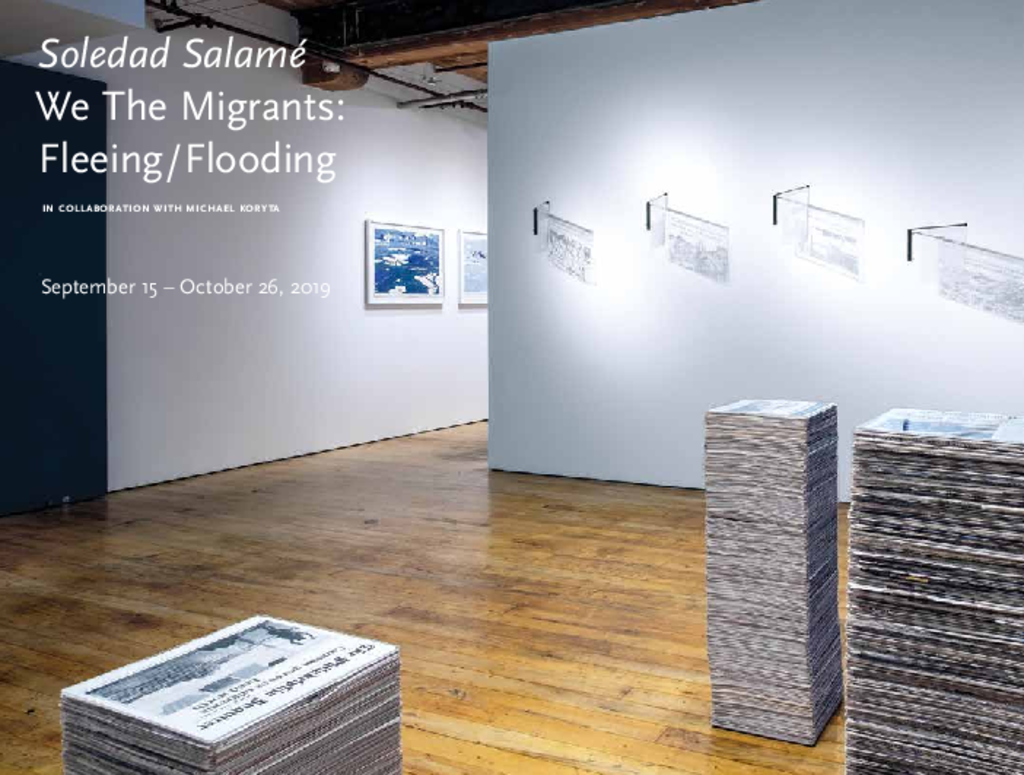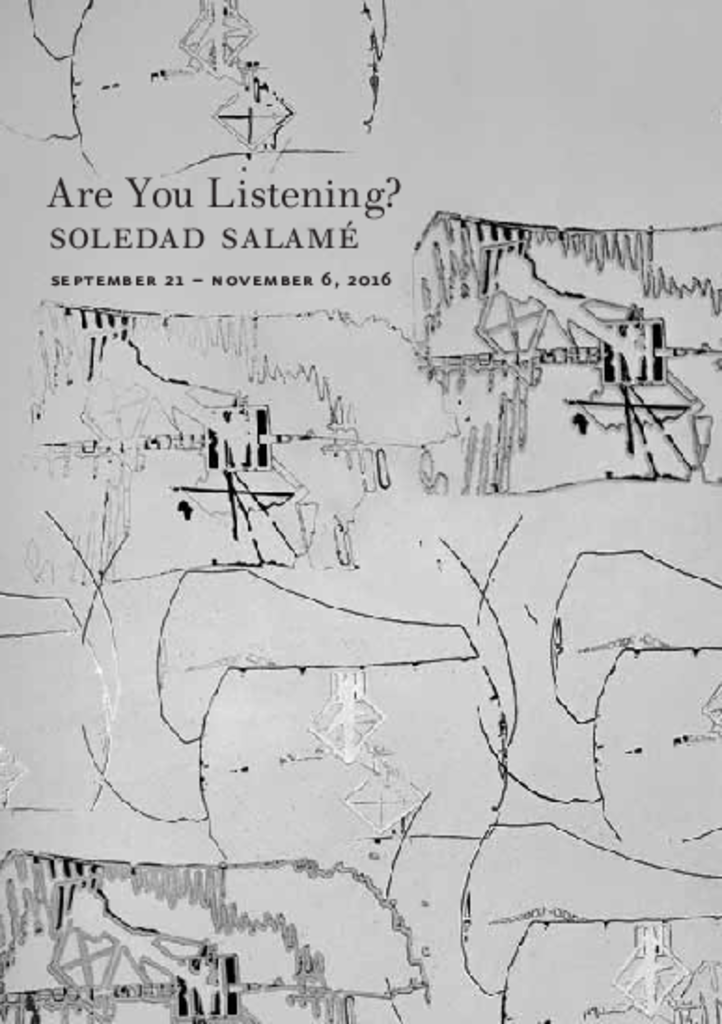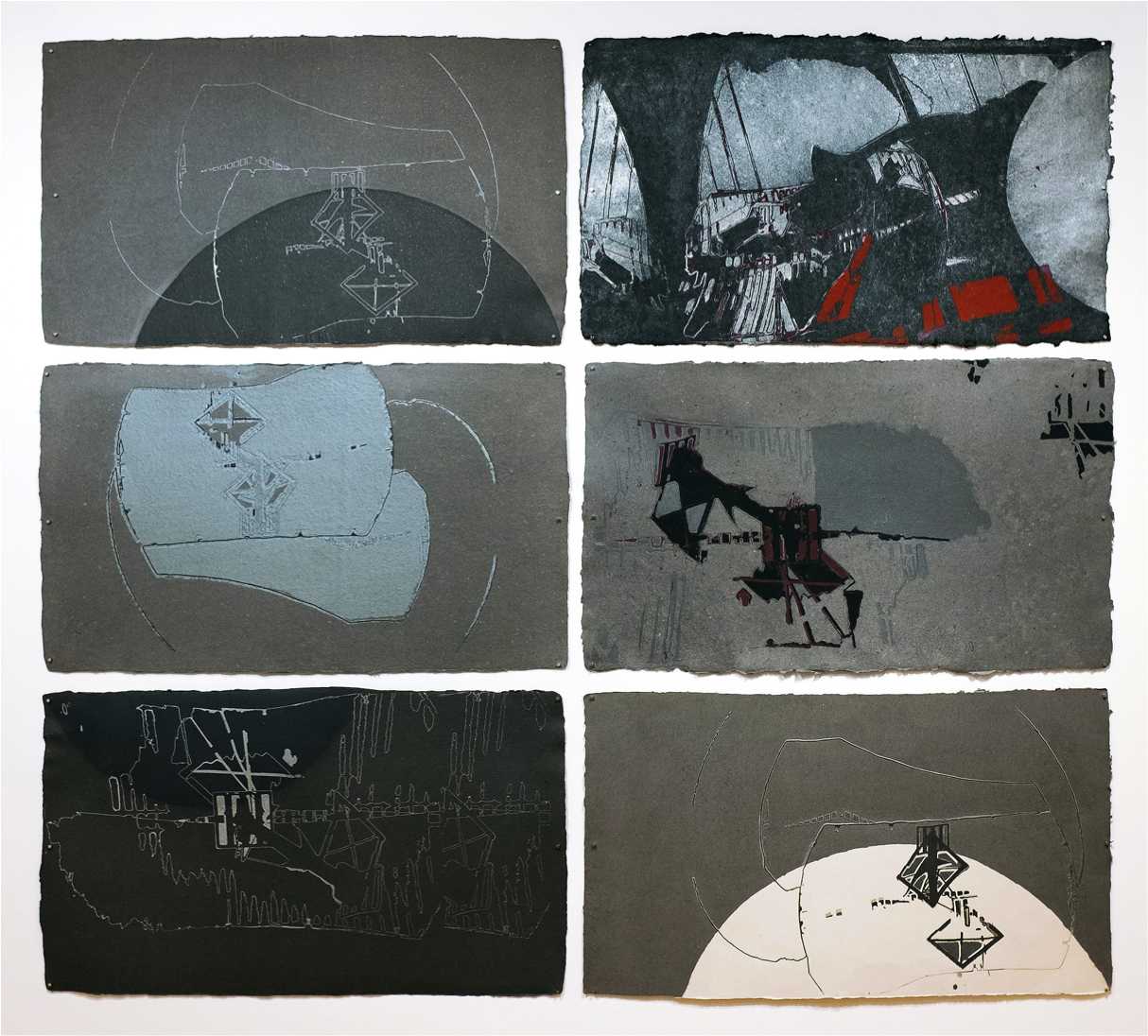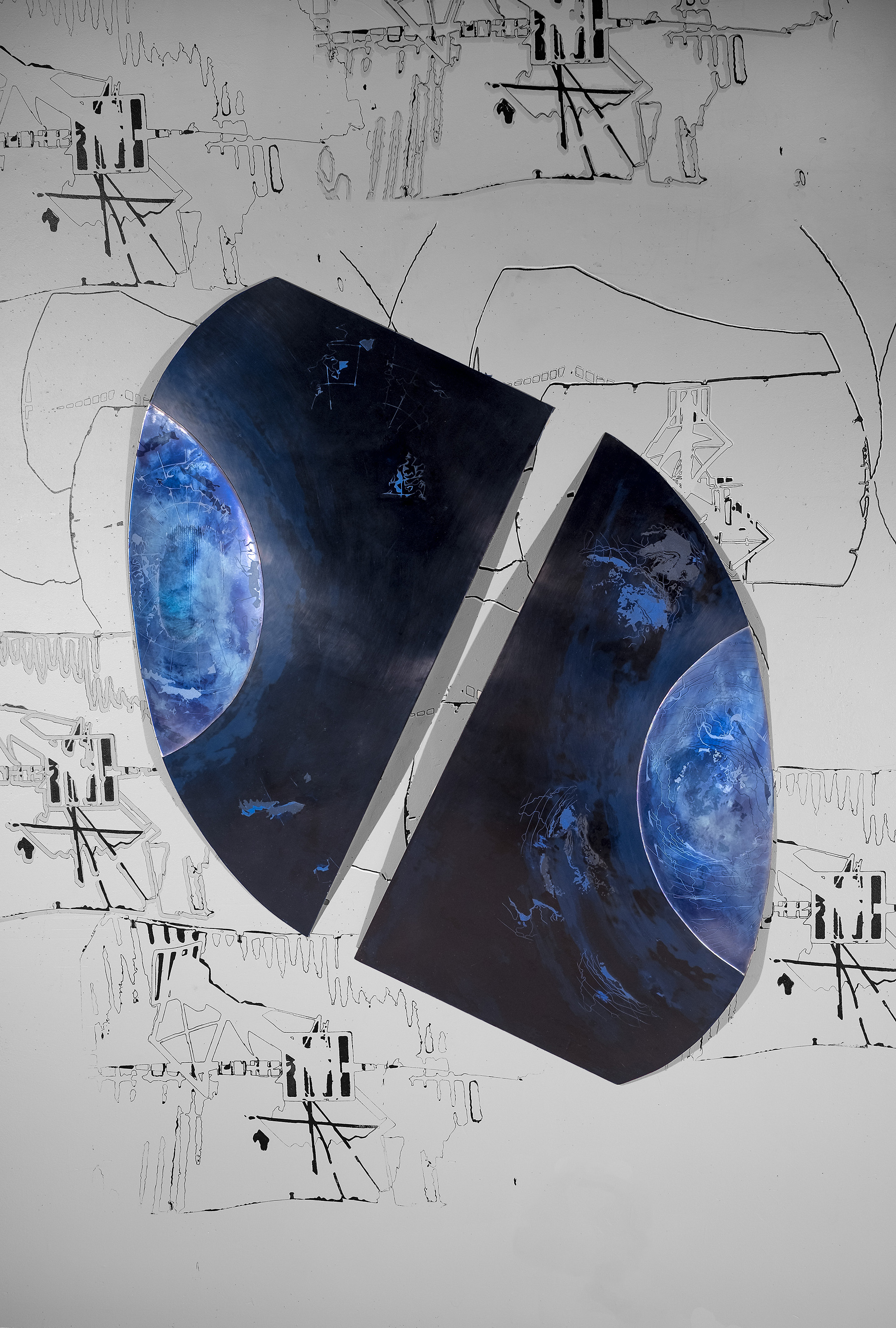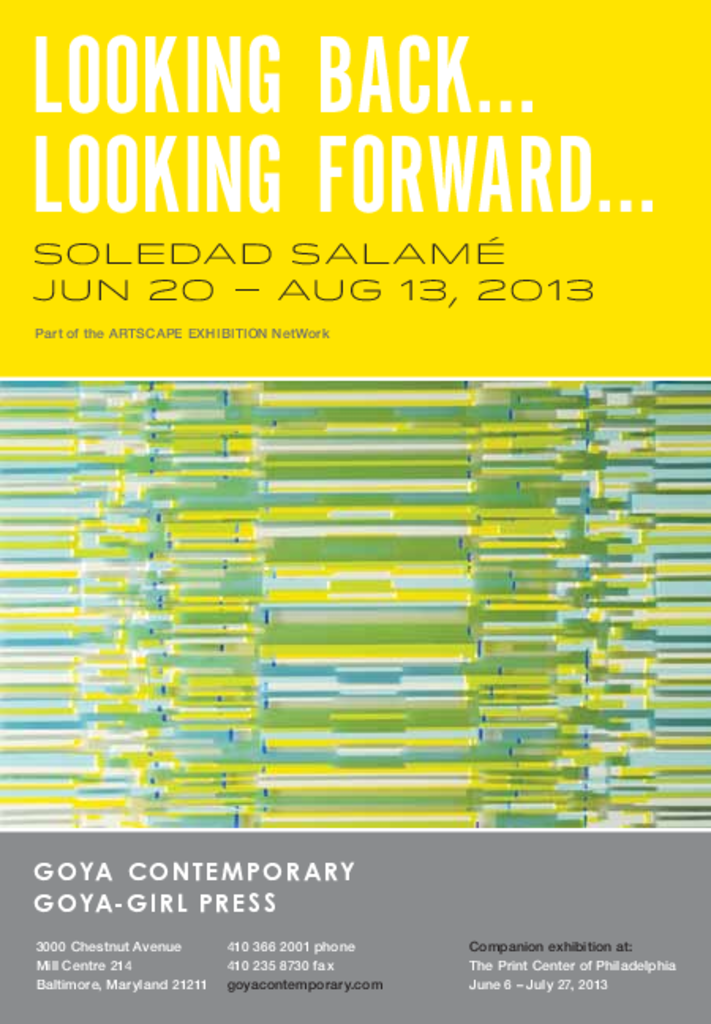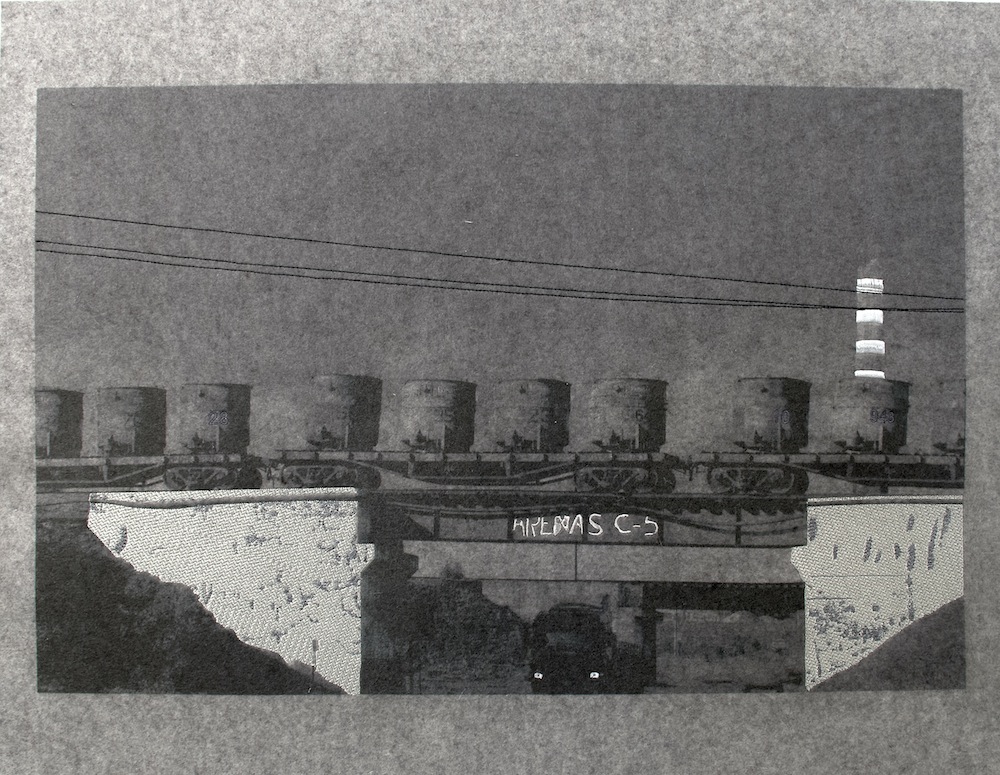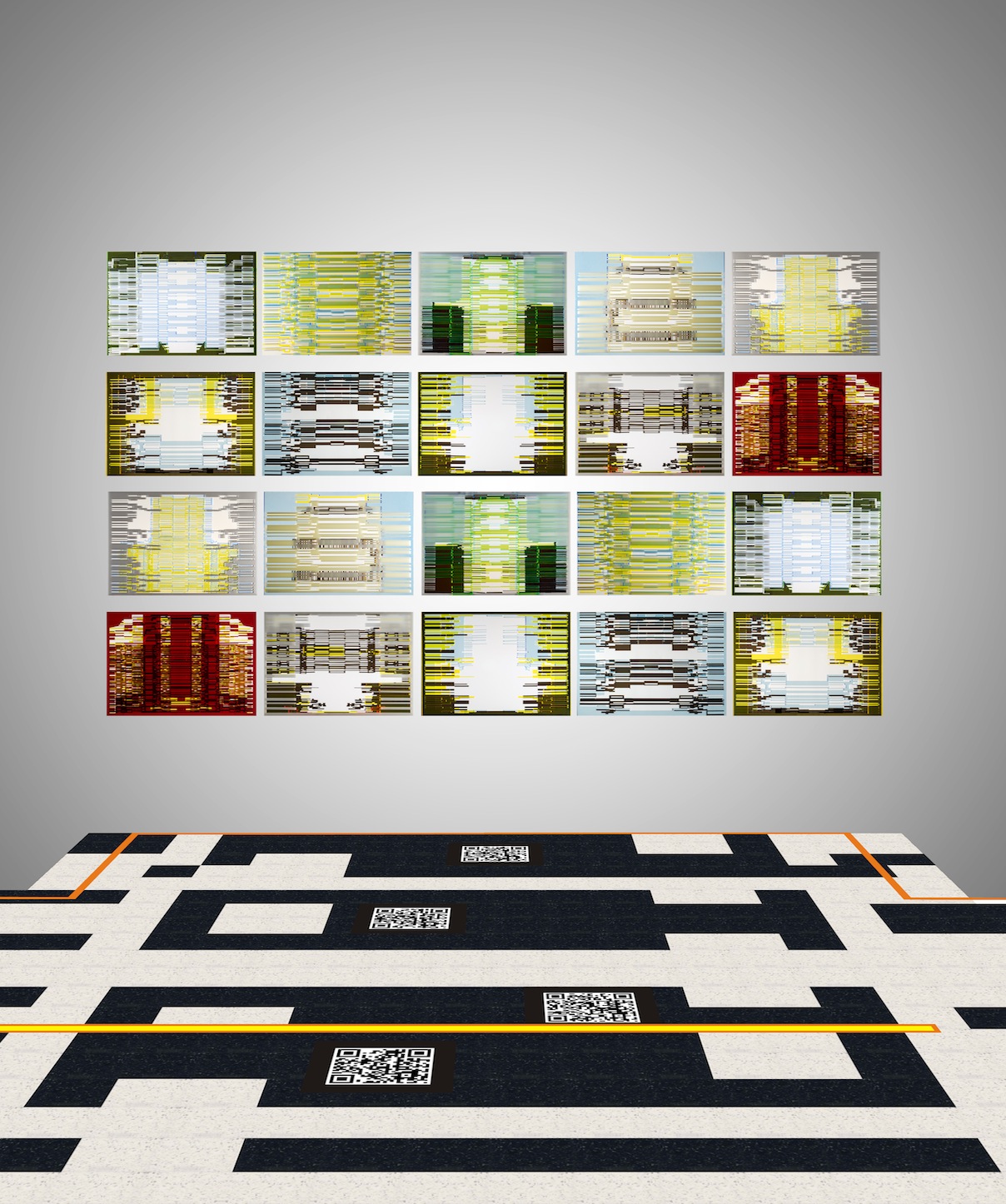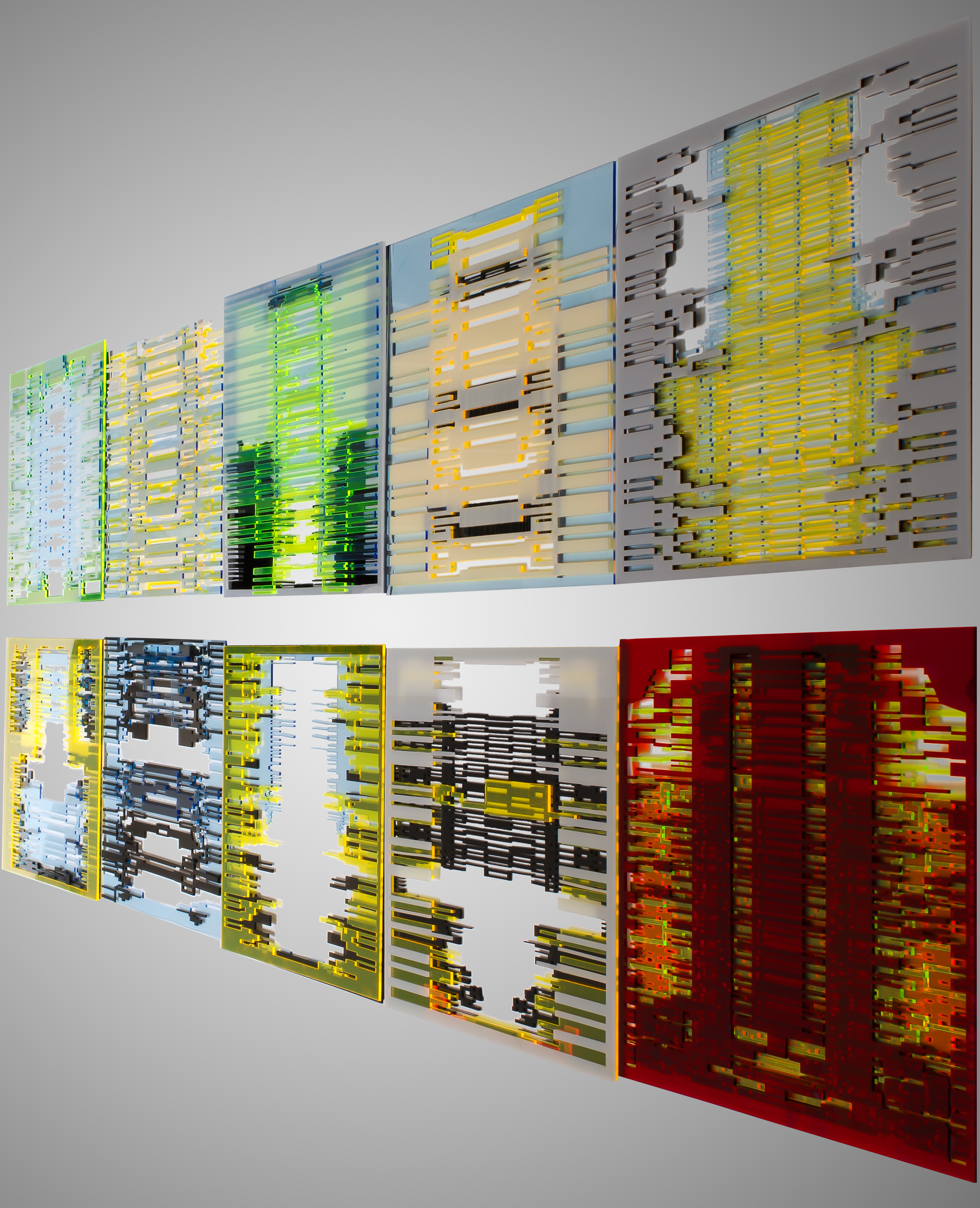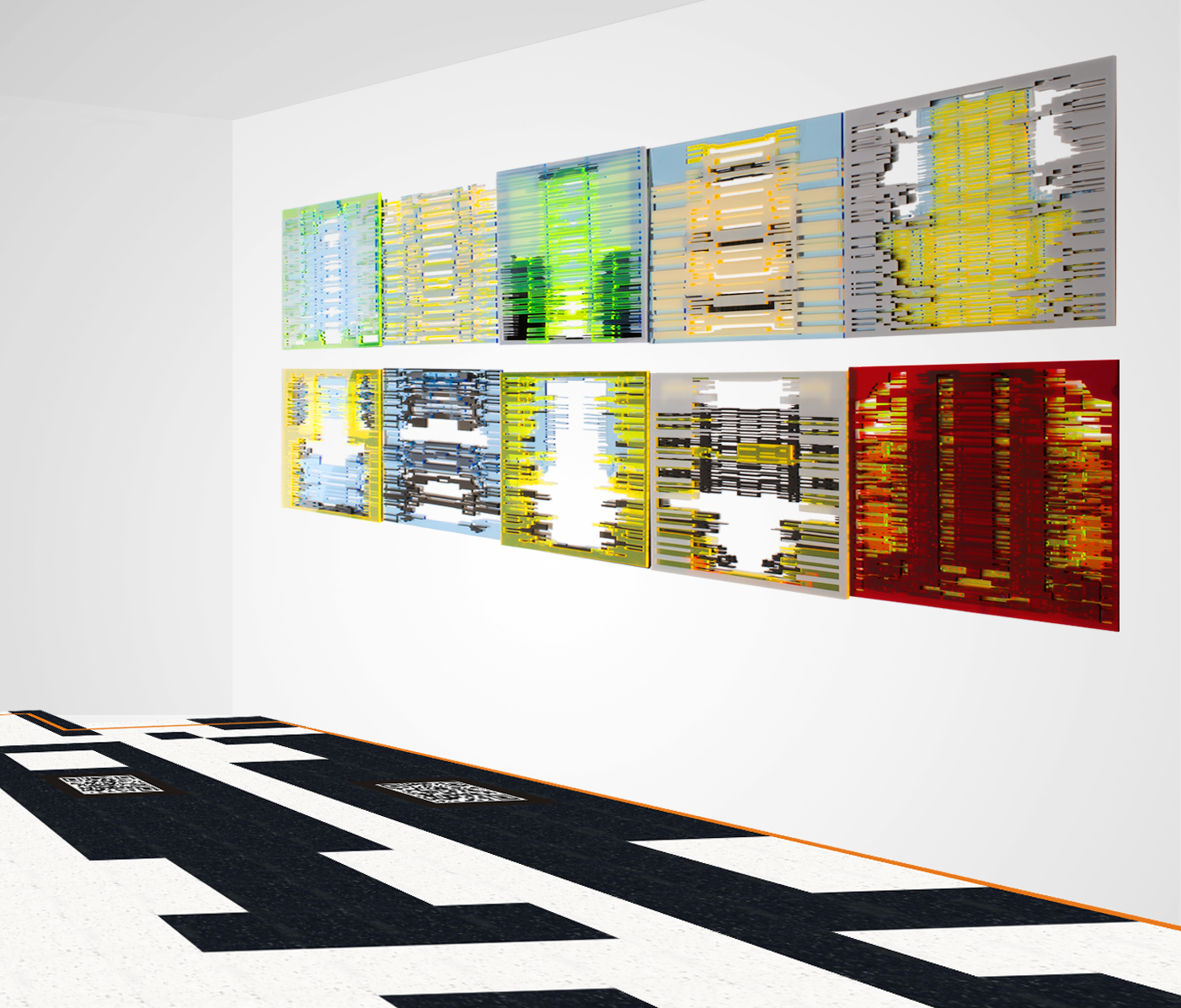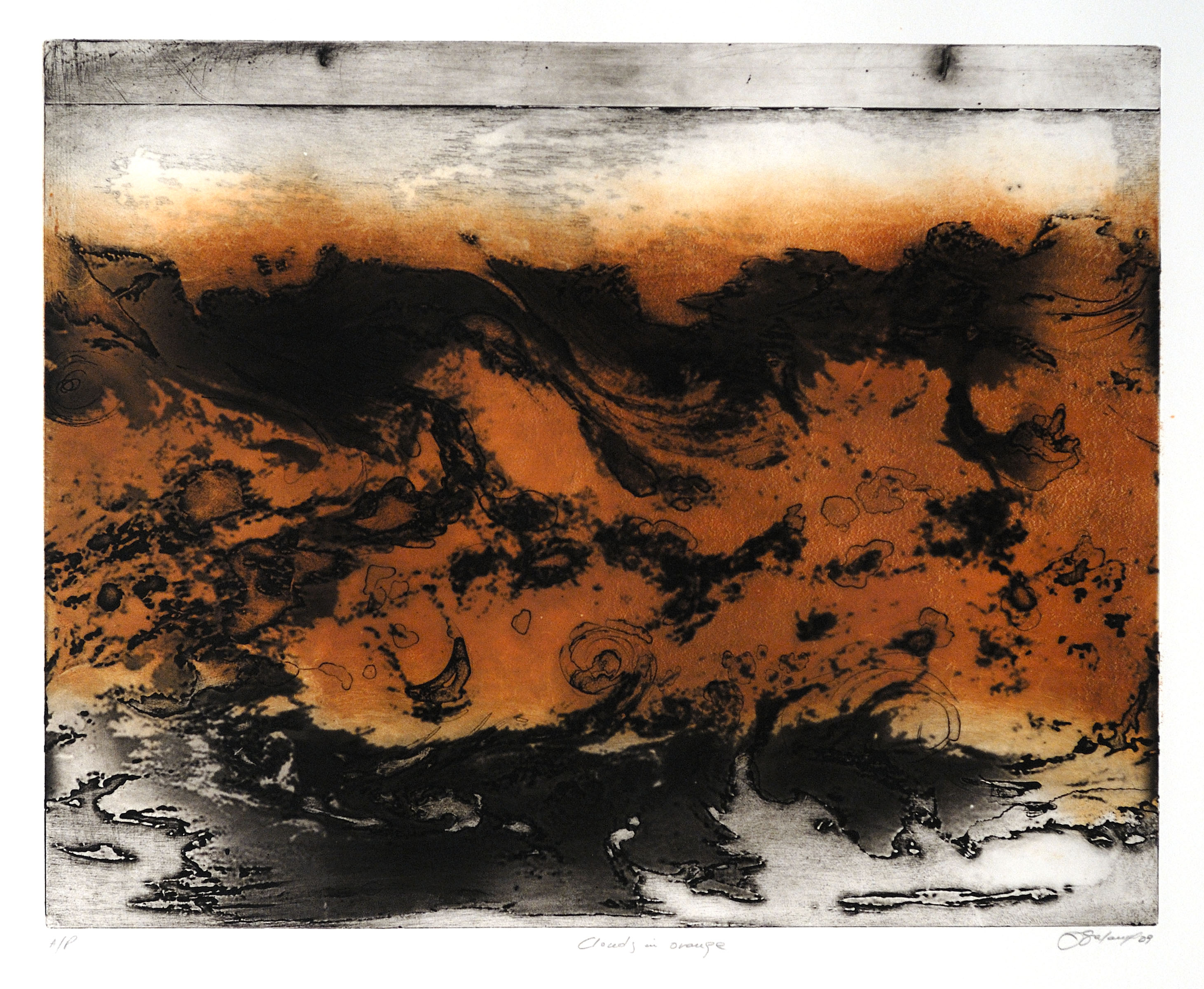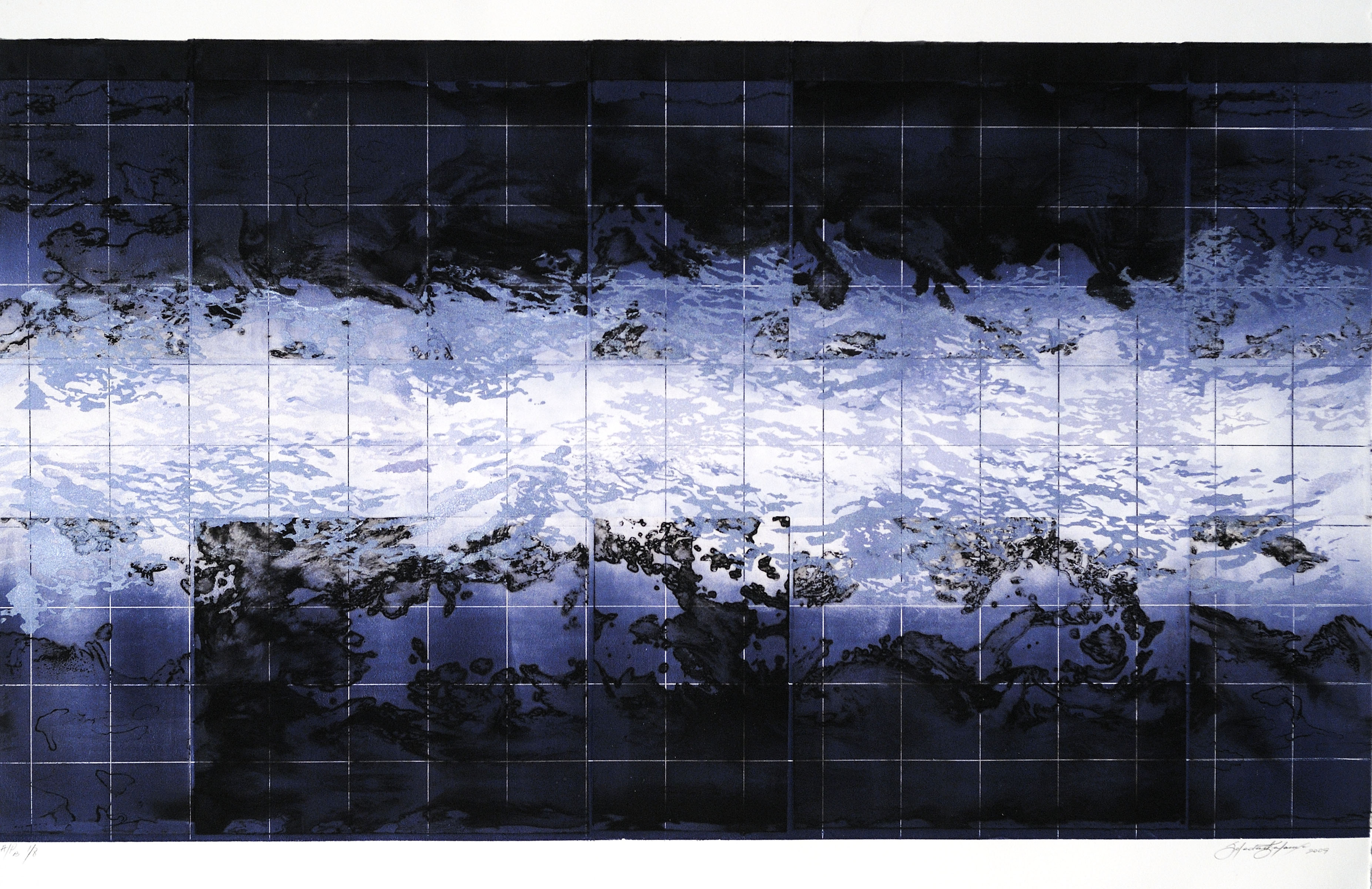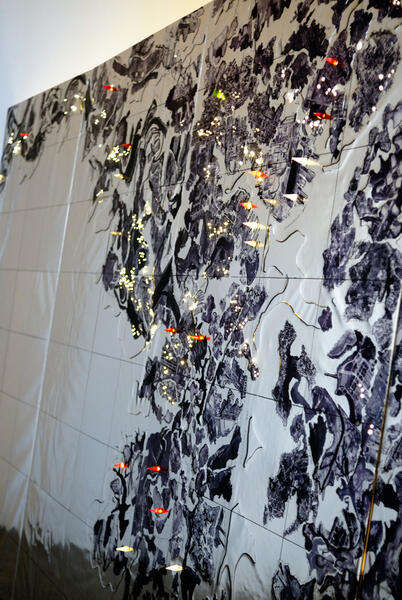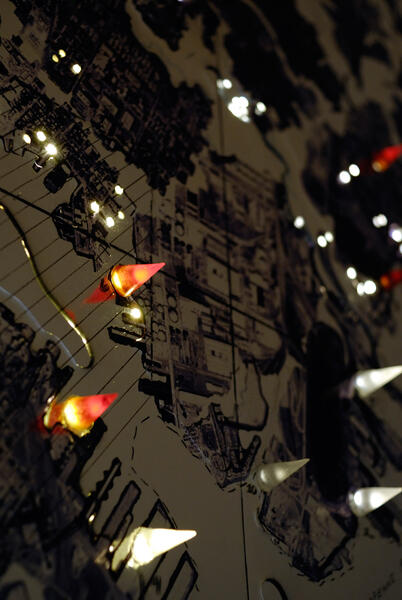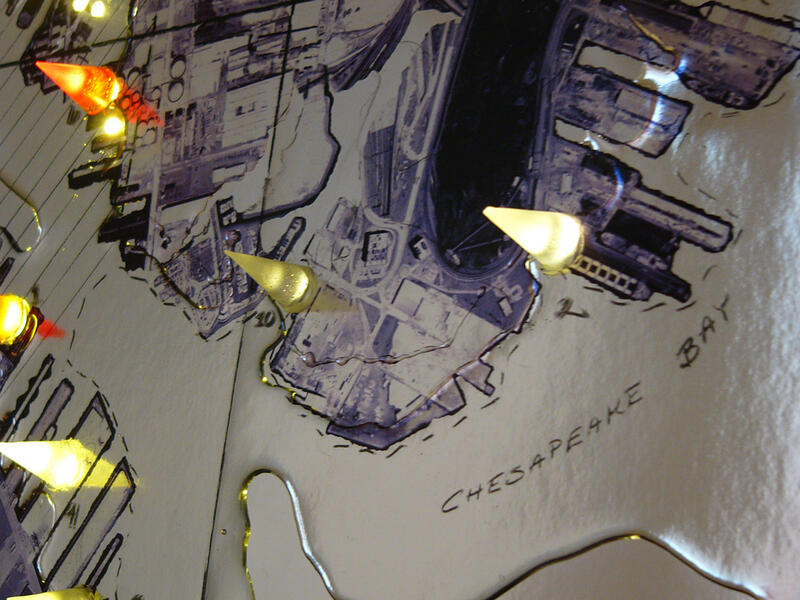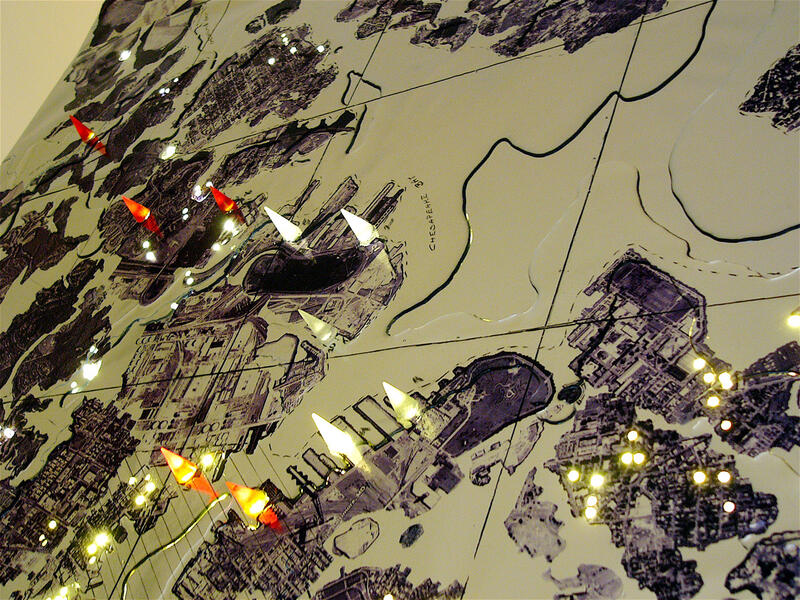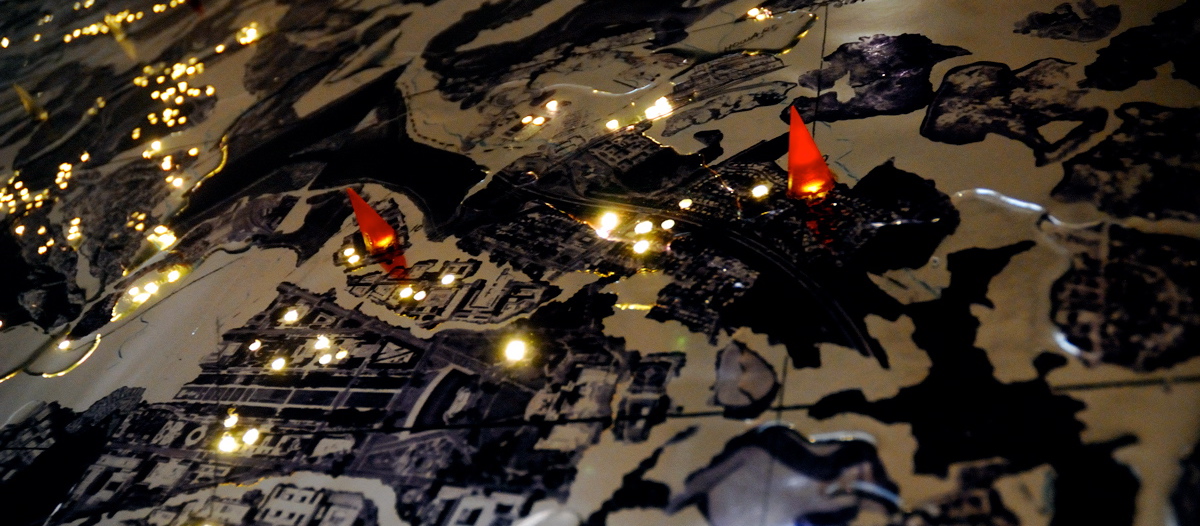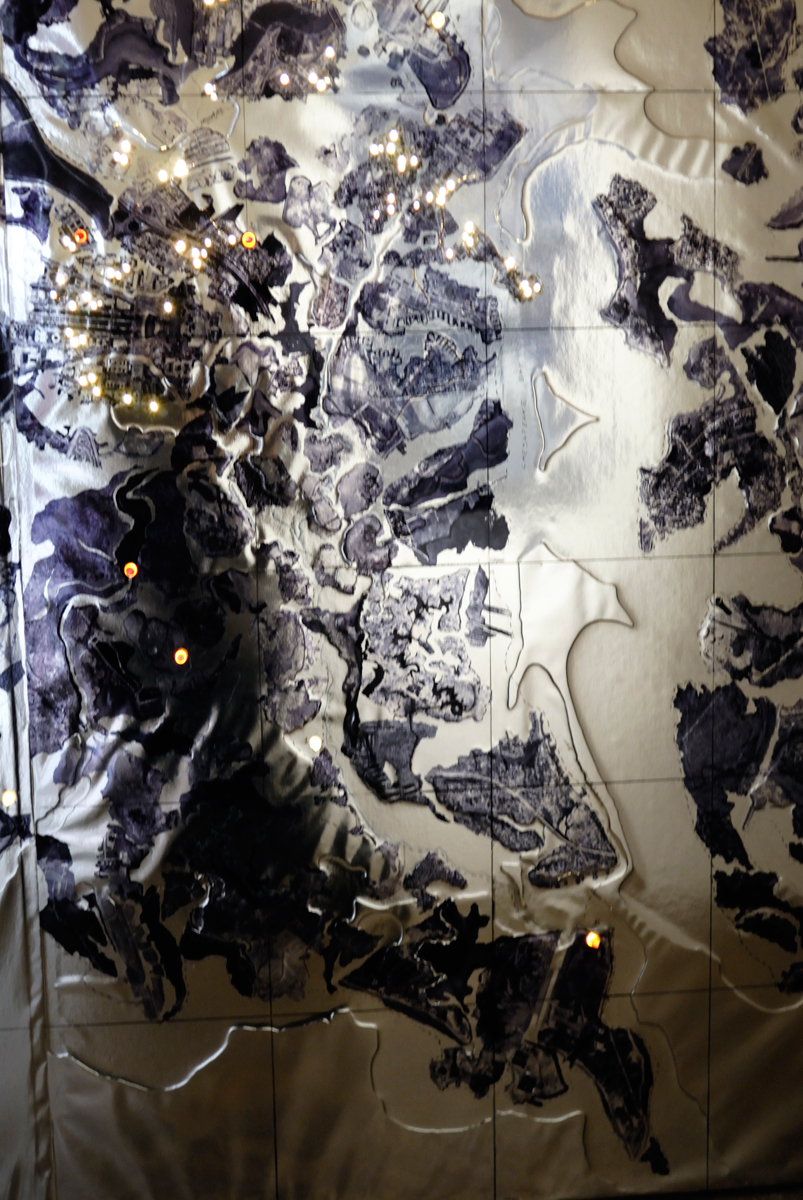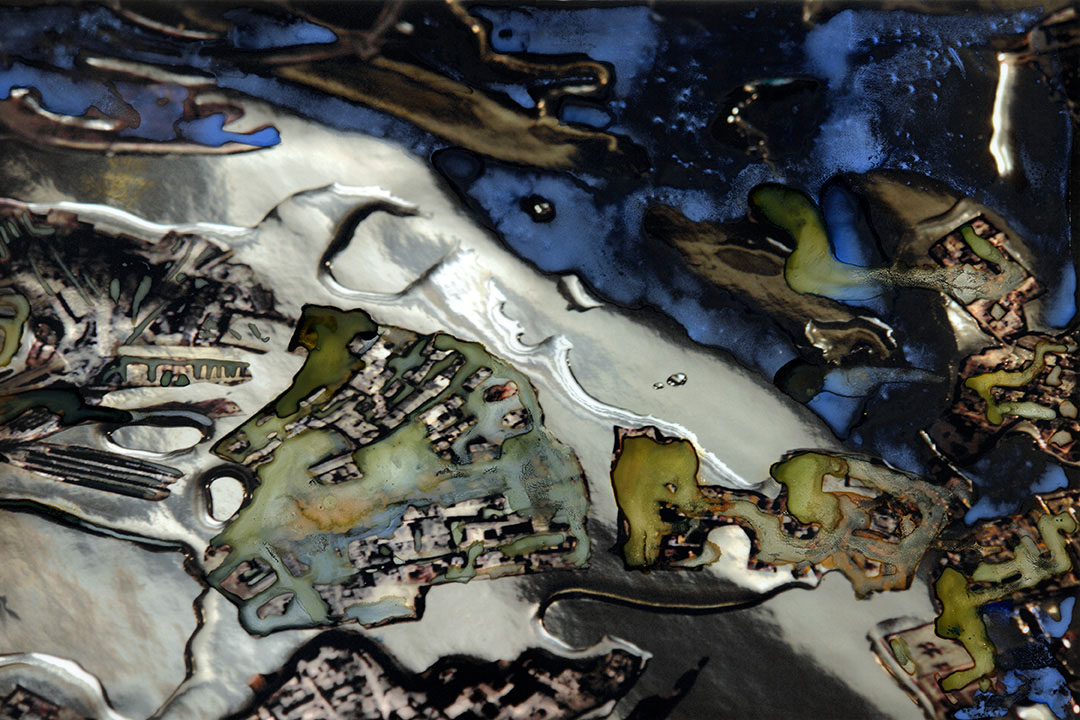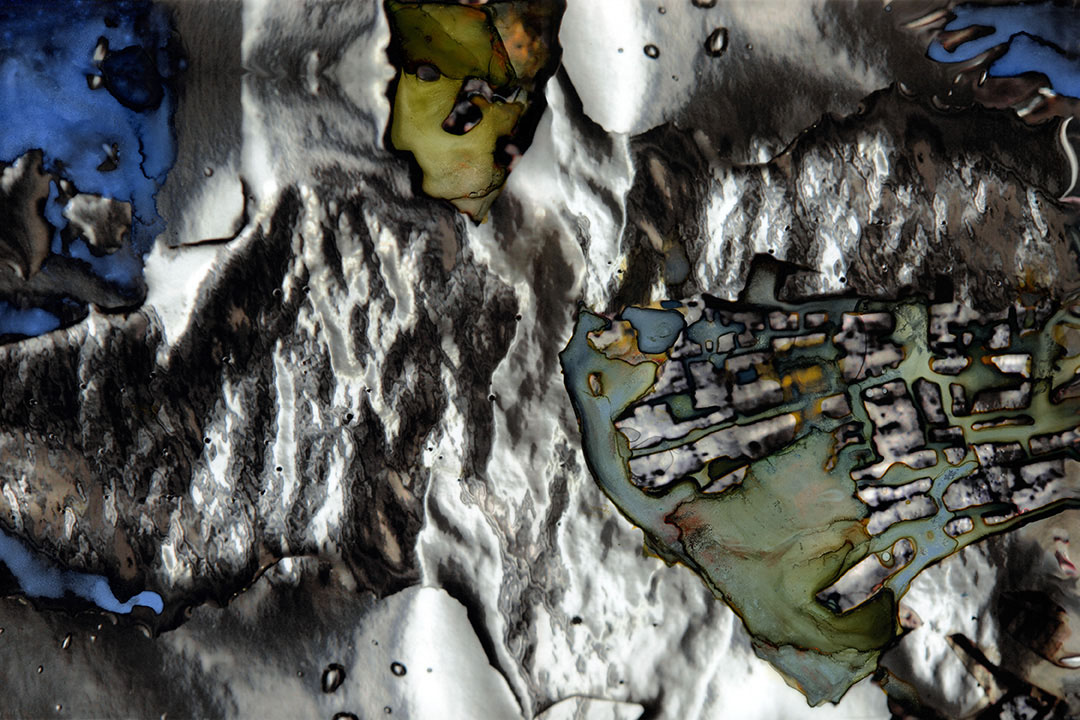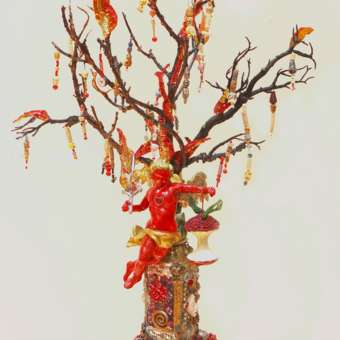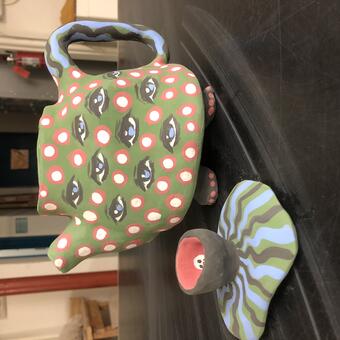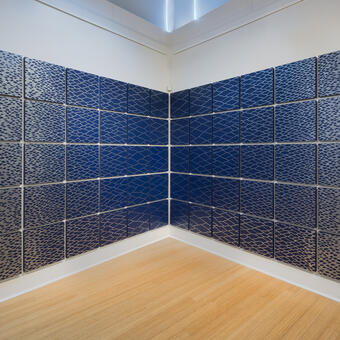Work samples
-
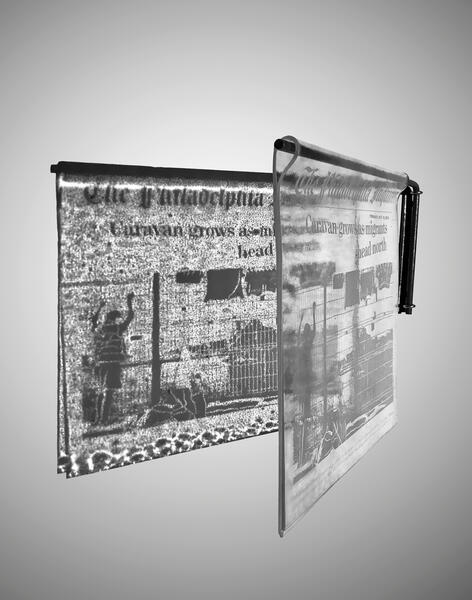 We the Migrants: Fleeing/Flooding 2019
We the Migrants: Fleeing/Flooding 2019View full catalog in project below.
I have designed a major series with 10 pieces that explore Post 9/11 policies, which have dramatically altered the treatment of immigrants in the United States. Mass migration in Central America and drought in South America. I have created prototype works with laser engraving and sandblasting on folded glass that imitate the size and appearance of a newspaper.These shadows mirror the imagery of the glass onto the referent wall, but in a distorted way. Therefore, for me, glass is important in representing and questioning the transparency of news and news reporting, and its misrepresentation. The distortion of the news and the distortion of the environment has been part of the work since 2011.
These are the real news images published by The Philadelphia Inquirer, embellished with embroidery and hand painted. These pieces accompany the folded glass objects, called Newspaper, Almost Transparent, that projects the distorted shadows and the distortion of the news.
Newspaper, Almost Transparent, 2019; Looking at Freedom
Engraved and sandblasted folded glass with articulated shadow projection print
12 x 12 x 12 inches, shadow projection: Variable is scaleLayered News I, 2019, Looking at Freedom
Embroidered prints on Fabriano paper
12" x 12" each -
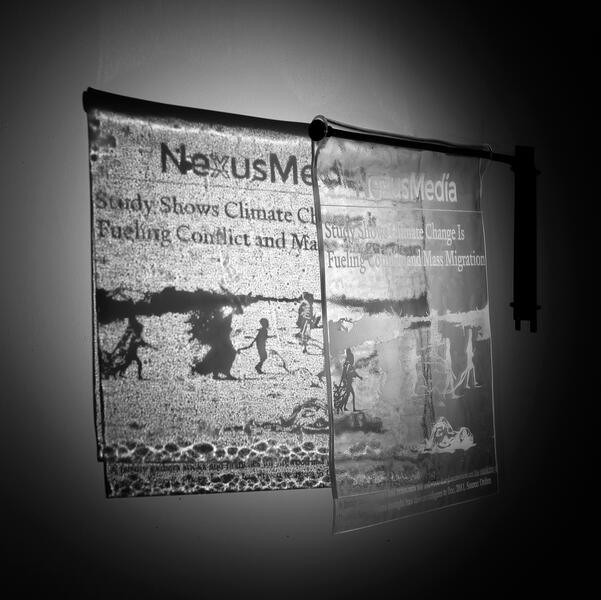 Newspaper, Almost Transparent; Climate Change Migration 2019
Newspaper, Almost Transparent; Climate Change Migration 2019View full catalog in project below.
I have designed a major series with 10 pieces that explore Post 9/11 policies, which have dramatically altered the treatment of immigrants in the United States. Mass migration in Central America and drought in South America. I have created prototype works with laser engraving and sandblasting on folded glass that imitate the size and appearance of a newspaper.These shadows mirror the imagery of the glass onto the referent wall, but in a distorted way. Therefore, for me, glass is important in representing and questioning the transparency of news and news reporting, and its misrepresentation. The distortion of the news and the distortion of the environment has been part of the work since 2011.
Newspaper, Almost Transparent, 2019; Climate Change Migration
Engraved and sandblasted folded glass with articulated shadow projection print
12 x 12 x 12 inches, shadow projection: Variable is scale -
 Fast Fashion Atacama Desert, 2023
Fast Fashion Atacama Desert, 2023Aerial photography with embroidery on canvas 2022
My current project began by means of aerial photography and videography. I used stills from these sources to create solar etchings that I have further manipulated with various hand processes including oil paint, watercolor, gouache, drawing, embroidery and collage.
-
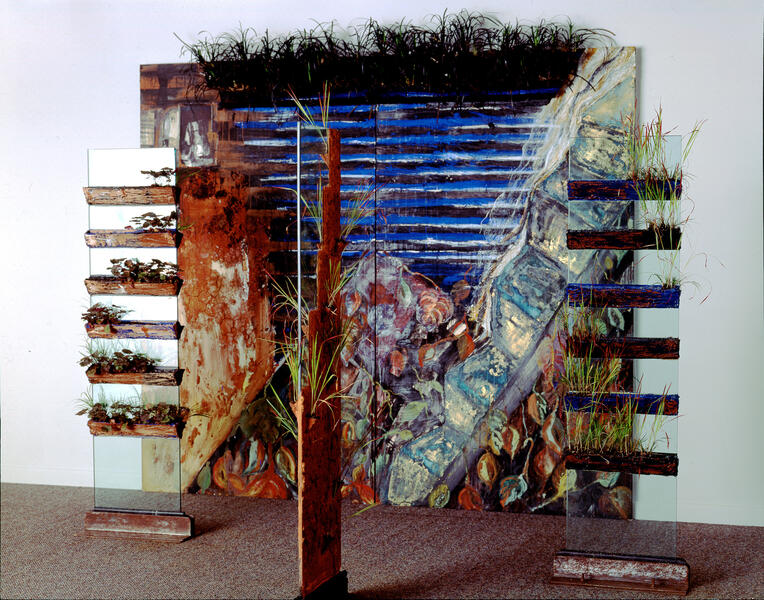 Garden of the Sacred Light 1994
Garden of the Sacred Light 1994Garden of the Sacred Light 1994
Mixed media on wood with plants, glass, metal, wood, gold leaf 8' X 8' X 5'In the early 90 I tried to integrate Architecture and Nature as a form of everyday life. This living painting was my first attempt after being exposed to the rainforest in Venezuela, and I was fascinated to see the environment and architecture so well integrated. Was published in several catalogs and book.
This work is based on my experience living in Caracas, Venezuela from 1973 to 1983.
Click here for exhibition material on page 21
About soledad

Soledad Salamé, American, was born in Chile in 1954. The artist moved to Baltimore in 1987 before establishing – in 2009 – a vibrant print studio in Baltimore. Salamé is an active member of the Baltimore arts community, and a lifelong educator. As an interdisciplinary artist, she creates work that originates from extensive investigation into specific topics. In the pursuit of new ideas, she has conducted intensive field research in the Americas, Antarctica, and beyond. Her… more
We The Migrants: Fleeing/ Flooding 2019
We The Migrants: Fleeing/Flooding title is based on The Constitution of The United States of America; Where it says, "We the People of the United States in order to form a more perfect Union, establish Justice, insure domestic tranquility, provide for the common defense, promote the general Welfare, and secure the Blessings of Liberty to ourselves and our Posterity, do ordain and establish this Constitution for the United States of America.”
Glass has a relationship to transparency, which is integral to the concept is a unique series of wall mounted objects titled Newspaper, Almost Transparent. Glass also creates a shadow as light passes through, and is interrupted b, surface changes. These shadows mirror the imagery of the glass onto the referent wall, but in a distorted way. Therefore, glass is important in representing and questioning the transparency of news and news reporting, and its misrepresentation.
I worked with Maryland glassblowing professional Tim McFadden to accomplish the series Newspaper, Almost Transparent. This size was specific to 12 x 12 inches representing the dimension of a folded newspaper
Click here to view exhibition catalog
-
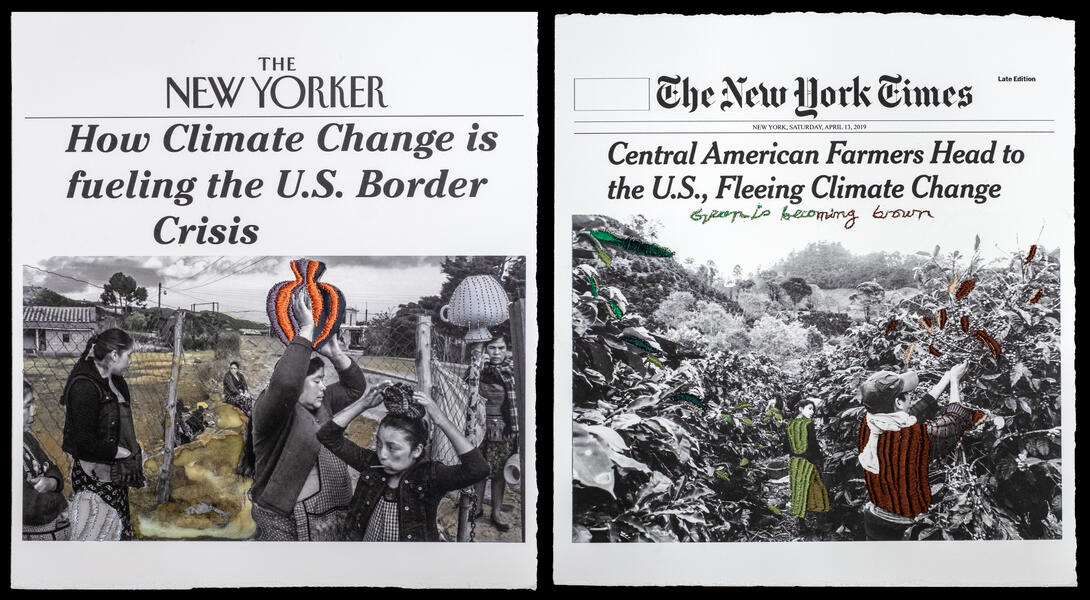 Layered News III & IV 2019
Layered News III & IV 2019These are the real news images published by The New Yorker and The New York Times embellished with embroidery and hand painted. These pieces accompany the folded glass objects, called Newspaper, Almost Transparent, that projects the distorted shadows and the distortion of the news.
Layered News III, 2019, Vases
Embroidered prints on Fabriano paper
12" x 12" eachLayered News IV, 2019, Green is Becoming Brown
Embroidered prints on Fabriano paper
12" x 12" each -
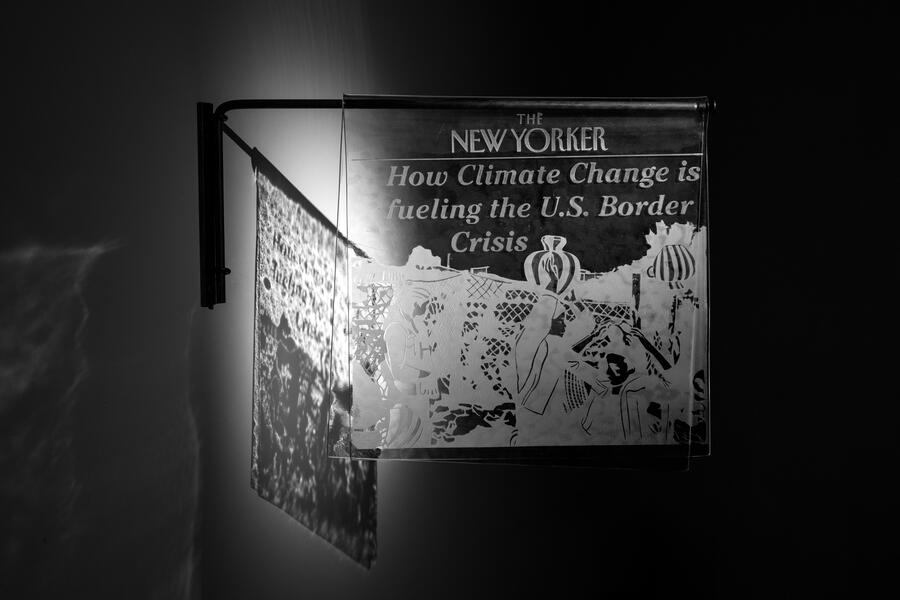 Newspaper, Almost Transparent; Water Vases 2019
Newspaper, Almost Transparent; Water Vases 2019View full catalog in project below.
I have designed a major series with 10 pieces that explore Post 9/11 policies, which have dramatically altered the treatment of immigrants in the United States. Mass migration in Central America and drought in South America. I have created prototype works with laser engraving and sandblasting on folded glass that imitate the size and appearance of a newspaper.These shadows mirror the imagery of the glass onto the referent wall, but in a distorted way. Therefore, for me, glass is important in representing and questioning the transparency of news and news reporting, and its misrepresentation. The distortion of the news and the distortion of the environment has been part of the work since 2011.
Newspaper, Almost Transparent, 2019; Water Vases
Engraved and sandblasted folded glass with articulated shadow projection print
12 x 12 x 12 inches, shadow projection: Variable is scale -
 We the Migrants: Fleeing/Flooding 2019
We the Migrants: Fleeing/Flooding 2019View full catalog in project below.
I have designed a major series with 10 pieces that explore Post 9/11 policies, which have dramatically altered the treatment of immigrants in the United States. Mass migration in Central America and drought in South America. I have created prototype works with laser engraving and sandblasting on folded glass that imitate the size and appearance of a newspaper.These shadows mirror the imagery of the glass onto the referent wall, but in a distorted way. Therefore, for me, glass is important in representing and questioning the transparency of news and news reporting, and its misrepresentation. The distortion of the news and the distortion of the environment has been part of the work since 2011.
These are the real news images published by The Philadelphia Inquirer, embellished with embroidery and hand painted. These pieces accompany the folded glass objects, called Newspaper, Almost Transparent, that projects the distorted shadows and the distortion of the news.
Newspaper, Almost Transparent, 2019; Looking at Freedom
Engraved and sandblasted folded glass with articulated shadow projection print
12 x 12 x 12 inches, shadow projection: Variable is scaleLayered News I, 2019, Looking at Freedom
Embroidered prints on Fabriano paper
12" x 12" each -
 Newspaper, Almost Transparent; Climate Change Migration 2019
Newspaper, Almost Transparent; Climate Change Migration 2019View full catalog in project below.
I have designed a major series with 10 pieces that explore Post 9/11 policies, which have dramatically altered the treatment of immigrants in the United States. Mass migration in Central America and drought in South America. I have created prototype works with laser engraving and sandblasting on folded glass that imitate the size and appearance of a newspaper.These shadows mirror the imagery of the glass onto the referent wall, but in a distorted way. Therefore, for me, glass is important in representing and questioning the transparency of news and news reporting, and its misrepresentation. The distortion of the news and the distortion of the environment has been part of the work since 2011.
Newspaper, Almost Transparent, 2019; Climate Change Migration
Engraved and sandblasted folded glass with articulated shadow projection print
12 x 12 x 12 inches, shadow projection: Variable is scale -
We the Migrants Video
This is the video exhibition at Goya Contemporary
-
 Newspaper, Almost Transparent; Katrina 2019
Newspaper, Almost Transparent; Katrina 2019View full catalog in project below.
I have designed a major series with 10 pieces that explore Post 9/11 policies, which have dramatically altered the treatment of immigrants in the United States. Mass migration in Central America and drought in South America. I have created prototype works with laser engraving and sandblasting on folded glass that imitate the size and appearance of a newspaper.These shadows mirror the imagery of the glass onto the referent wall, but in a distorted way. Therefore, for me, glass is important in representing and questioning the transparency of news and news reporting, and its misrepresentation. The distortion of the news and the distortion of the environment has been part of the work since 2011.
Newspaper, Almost Transparent, 2019; Katrina
Engraved and sandblasted folded glass with articulated shadow projection print
12 x 12 x 12 inches, shadow projection: Variable is scale
Are You Listening? 2016
Are You Listening? is a brief investigation of how humans look for answers outside their world rather than looking directly at their world.
In the barren Atacama dessert, home to the most sophisticated radio telescopes in the world, scientists are desperately trying to understand the universe. Are You Listening? Addresses the contradiction between two extremes of approaching our existence, technological and the verdant agricultural.
Click here to view exhibition catalog
-
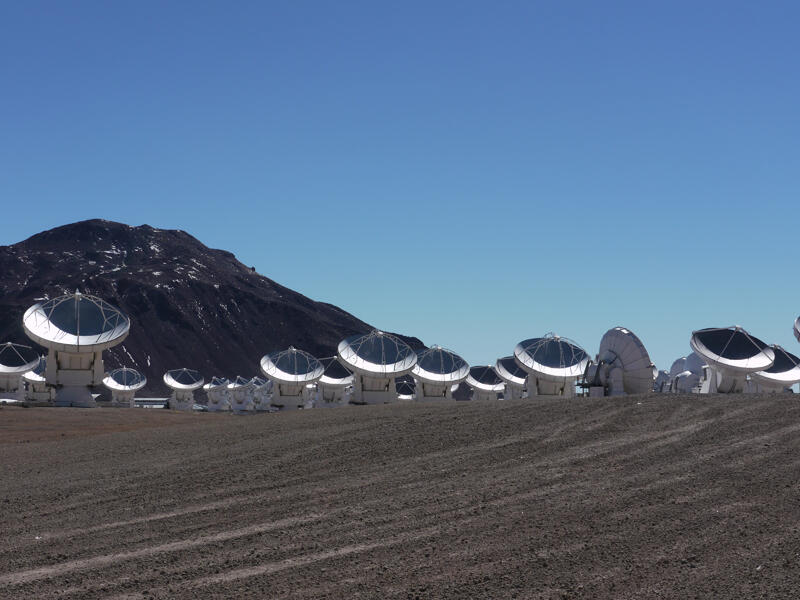 ALMA (Atacama Large Millimeter Array) in Chile's Atacama Desert
ALMA (Atacama Large Millimeter Array) in Chile's Atacama DesertDigital photograph taken at ALMA (Atacama Large Millimeter Array) at an altitude of 5,000 meters (16500 feet). Alma consists of 65 parabolic dishes, 54 of which are 12 meters (39 feet) in diameters and 12 which are 7 meters (23 feet) in diameter.
-
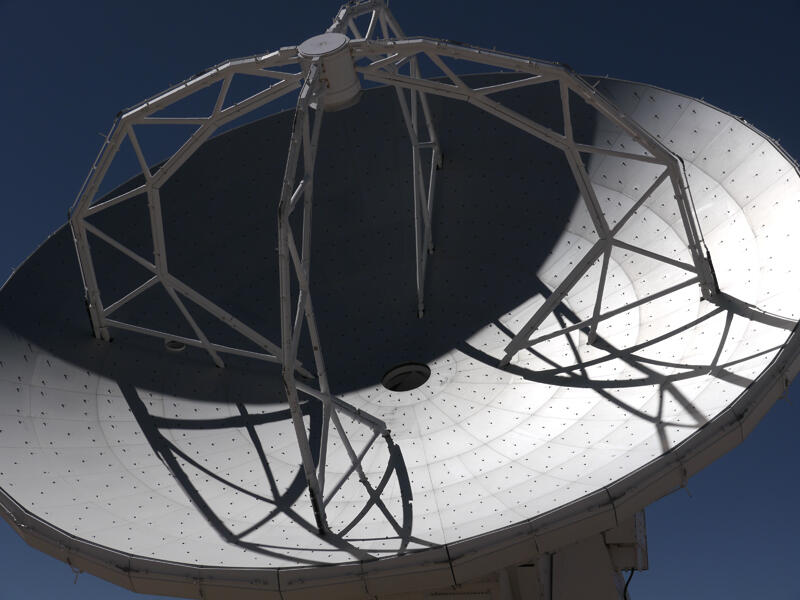 ALMA (Atacama Large Millimeter Array) closeup in Chile's Atacama Desert
ALMA (Atacama Large Millimeter Array) closeup in Chile's Atacama DesertDigital photograph taken at ALMA (Atacama Large Millimeter Array) at an altitude of 5,000 meters (16500 feet). Alma consists of 65 parabolic dishes, 54 of which are 12 meters (39 feet) in diameters and 12 which are 7 meters (23 feet) in diameter.
-
Are You Listening, Video 2016
-
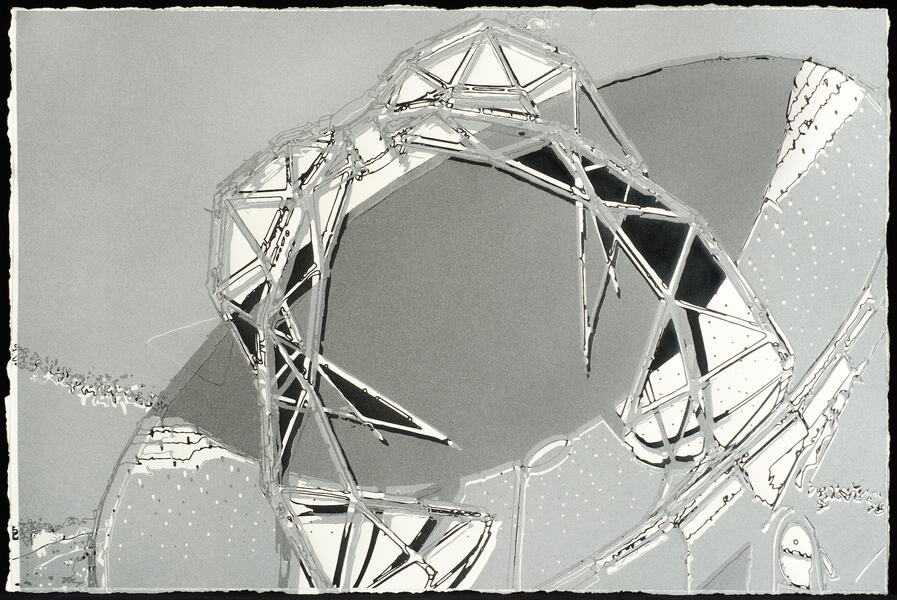 ALMA: Are you listening 2014
ALMA: Are you listening 2014After visiting ALMA in the desert of Atacama in Chile, I developed a series of prints, video, sculptures and handmade paper work. I had to work with an oxygen tank because of it's altitude. The ALMA antennas are located at the Array Operations Site (AOS) on the Chajnantor plateau of the Chilean Andes at an altitude of 5000 meters, about 40 km east of the village of San Pedro de Atacama.
AP 1/7
Silkscreen and relief printing on Fabriano paper
14 3/4 x 23 1/4 inches each -
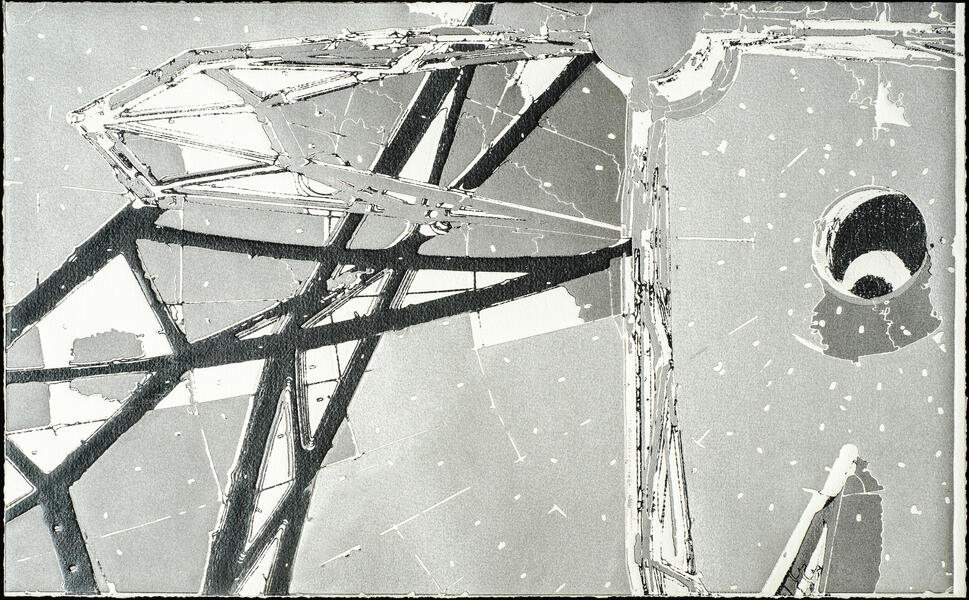 AntennaPrint_3_0.jpg
AntennaPrint_3_0.jpgAfter visiting ALMA in the desert of Atacama in Chile, I developed a series of prints, video, sculptures and handmade paper work. I had to work with an oxygen tank because of it's altitude. The ALMA antennas are located at the Array Operations Site (AOS) on the Chajnantor plateau of the Chilean Andes at an altitude of 5000 meters, about 40 km east of the village of San Pedro de Atacama.
AP 1/7
Silkscreen and relief printing on Fabriano paper
14 3/4 x 23 1/4 inches each -
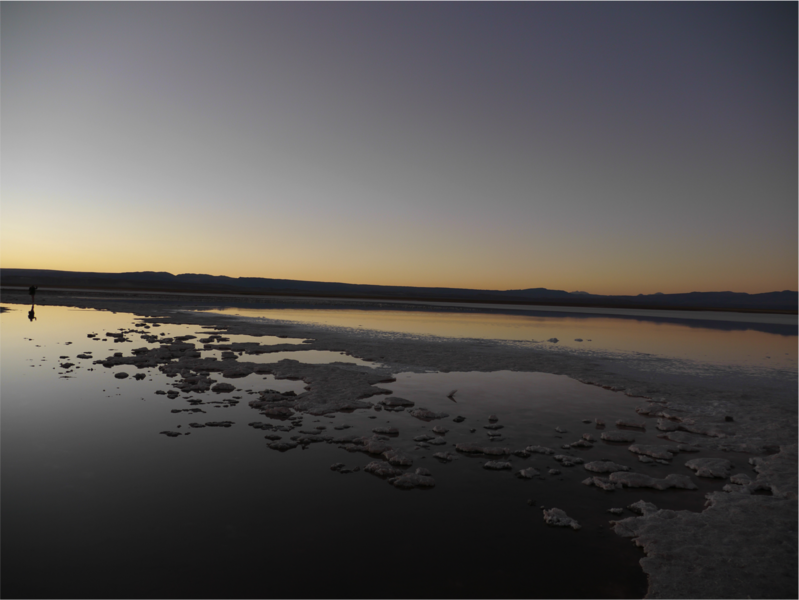 Salar of Atacama Desert; salt Landscape
Salar of Atacama Desert; salt LandscapeSalar de Atacama, located 55 km (34 mi) south of San Pedro de Atacama, is the largest salt flat in Chile. It is surrounded by mountains and lacks drainage outlets. To the east, it is enclosed by the main chain of the Andes, while to the west lies a secondary mountain range called Cordillera de Domeyko.
-
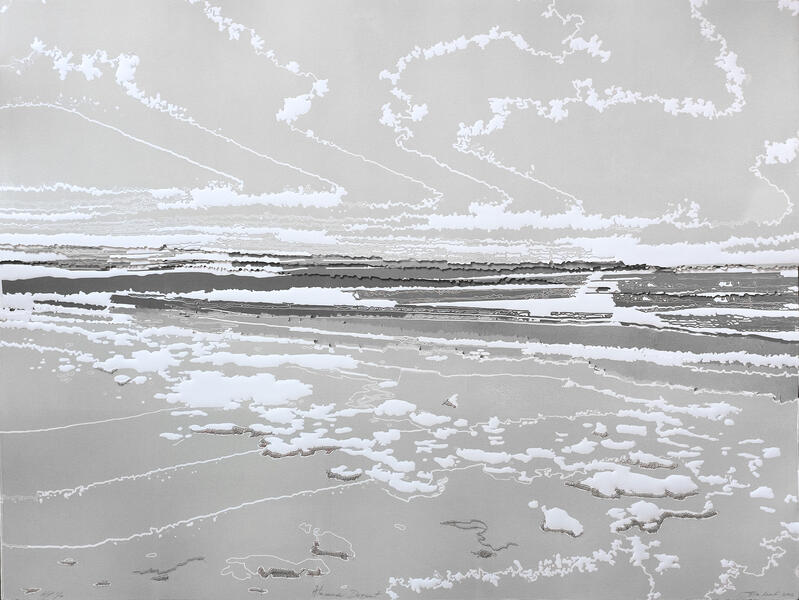 Atacama Desert print 2016
Atacama Desert print 2016Based on the Salar Atacama photographs, I have created a multi layer print, to portray my experience in that Salar. With embroidery and sewing on a 600g Fabriano paper.
Etching, embossing, laser cutting, embroidery on layered Fabriano paper
30 x 40 inches -
 Shadows I, II, III, IV, V, VI, 2015-2016
Shadows I, II, III, IV, V, VI, 2015-2016This work was created with artist Helen Frederick Paper Studio.
Silkscreen on hand-crafted pulp paper and hand painting
40” x 24.5 each -
 North and South Pole 2016
North and South Pole 2016North and South Pole, 2015-2016
Wood, epoxy resin, silk screen, enamel
34 1/2 x 21 x 2 inches (total size variable)
Looking Back, Looking Forward 2013
-
 Ramot Jerusalem 2013
Ramot Jerusalem 2013Based on the book by Emmet Gowin, "Changing the Earth". This book is based in how human hands have changed the surface of the earth. I decided to interpret his photographs by the process of laser cutting, printing, embossing, and sewing. Ramot Jerusalem, has a very small edition because each print has 5-8 papers printed to create the three dimensionality. After asking for permission to Emmet Gowin, to use his images, I decided to put the page number, (Page 39) in sewing as a reference to the book.
Printing, laser cutting, embossing and sewing on 600 gram Fabriano paper
24 " X 16"
2013 -
 Czech Republic 2013
Czech Republic 2013Based on the book by Emmet Gowin, "Changing the Earth". This book is based in how human hands have changed the surface of the earth. I decided to interpret his photographs by the process of laser cutting, printing, embossing, and sewing. Czech Republic, has a very small edition because each print has 5-8 papers printed to create the three dimensionality. After asking for permission to Emmet Gowin, to use his images, I decided to put the page number, (Page 69) in sewing as a reference to the book.
Printing, laser cutting, embossing and sewing on 600 gram Fabriano paper
24 " X 16"
2013 -
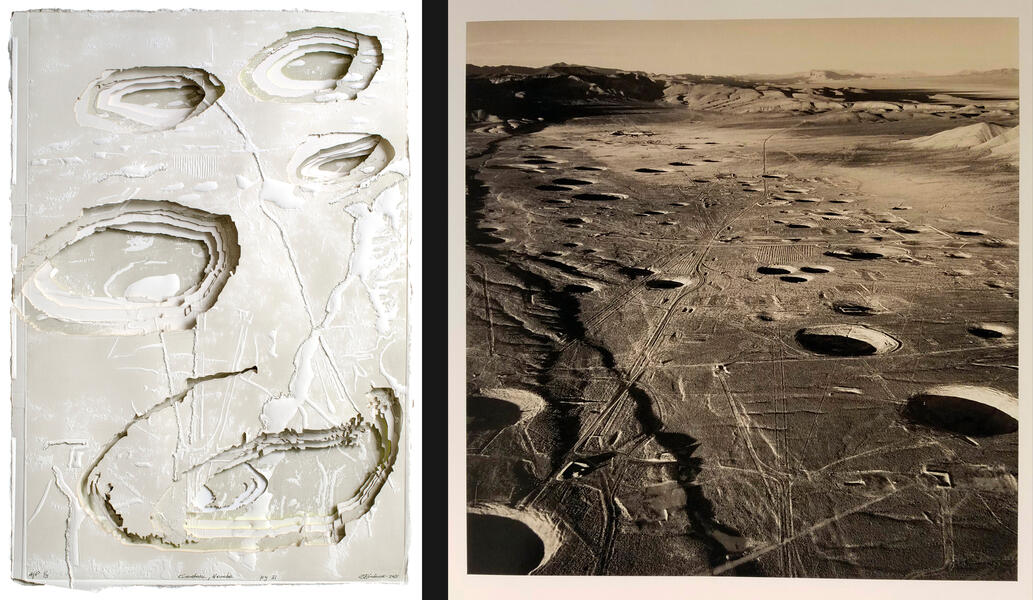 Craters Nevada 2013
Craters Nevada 2013Based on the book by Emmet Gowin, "Changing the Earth". This book is based in how human hands have changed the surface of the earth. I decided to interpret his photographs by the process of laser cutting, printing, embossing, and sewing. Craters Nevada, has a very small edition because each print has 5-8 papers printed to create the three dimensionality. After asking for permission to Emmet Gowin, to use his images, I decided to put the page number, (Page 95) in sewing as a reference to the book.
Printing, laser cutting, embossing and sewing on 600 gram Fabriano paper
24 " X 16"
2013 -
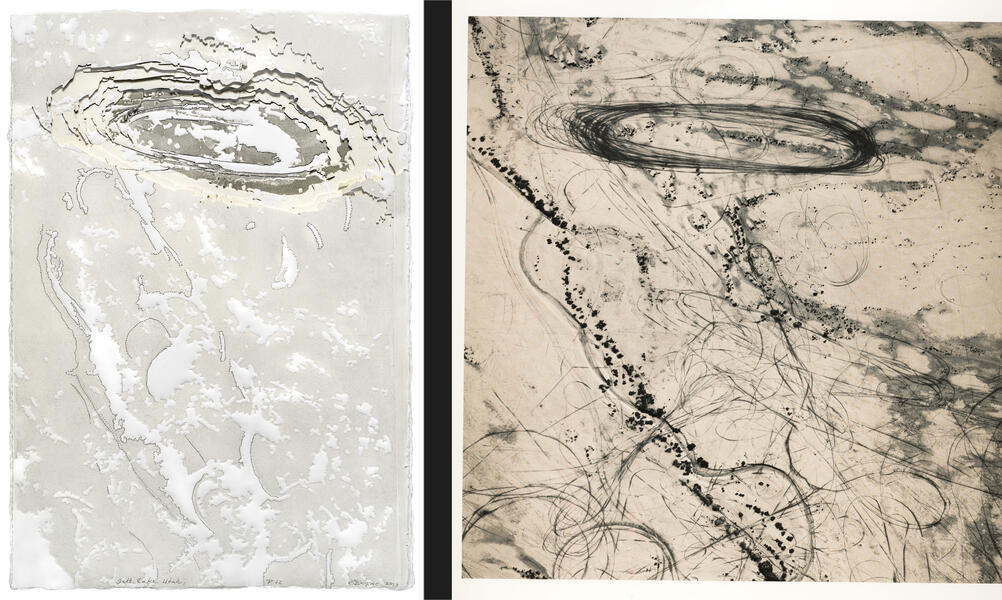 Salt Lake Utah 2013
Salt Lake Utah 2013Based on the book by Emmet Gowin, "Changing the Earth". This book is based in how human hands have changed the surface of the earth. I decided to interpret his photographs by the process of laser cutting, printing, embossing, and sewing. Salt Lake, has a very small edition because each print has 5-8 papers printed to create the three dimensionality. After asking for permission to Emmet Gowin, to use his images, I decided to put the page number, (Page 12) in sewing as a reference to the book.
Printing, laser cutting, embossing and sewing on 600 gram Fabriano paper
24 " X 16"
2013 -
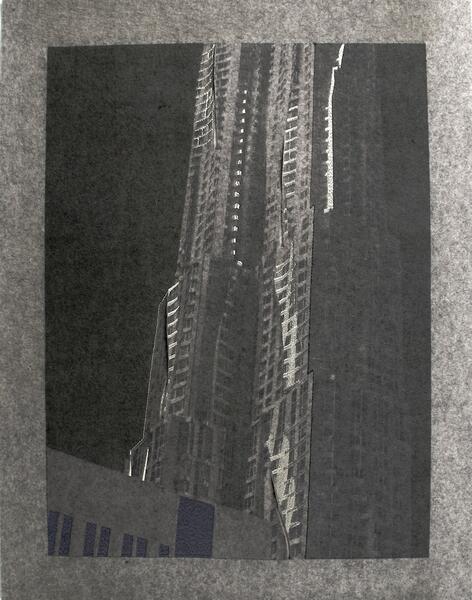 Gehry 2013
Gehry 2013This series of prints were created with Goya Contemporary and Solo Impression, NY. After photographing a series of industrial sites in different parts of the United States and South America, I selected this iconic image that shows how the light falls on the Frank Gehry building.
Print on Industrial felt with embroidery
26 " X 20"
2013 -
 Chile Tanks 2013
Chile Tanks 2013This series of prints were created with Goya Contemporary and Solo Impression, NY. After photographing a series of industrial sites in different parts of the United States and South America, I selected this iconic image that shows old, decaying technology of the coal industry.
Print on Industrial felt with embroidery
20 " X 28"
2013 -
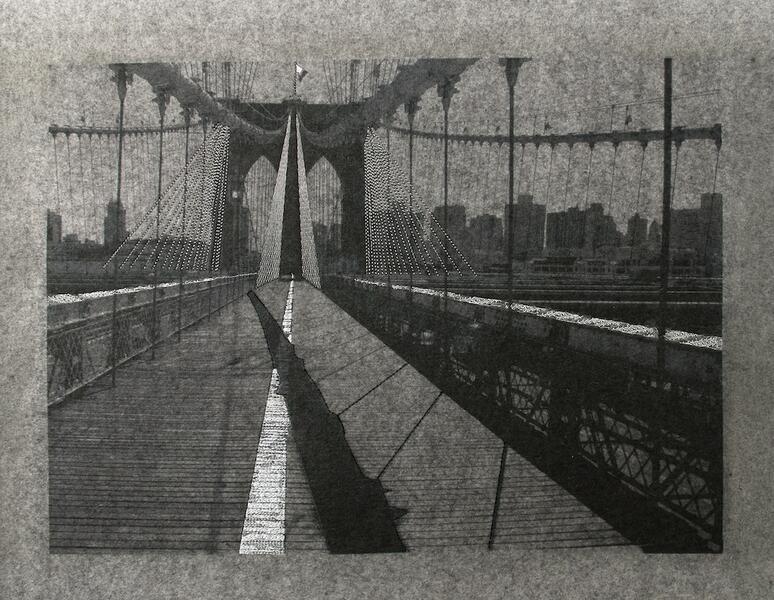 Brooklyn Bridge 2013
Brooklyn Bridge 2013This series of prints were created with Goya Contemporary and Solo Impression, NY. After photographing a series of industrial sites in different parts of the United States and South America, I selected this iconic image that shows how the light falls on the Brooklyn Bridge.
Print on Industrial felt with embroidery
20 " X 26"
2013
Barcodes: Merging Identity and Technology 2012-2013
Barcodes: Merging Identity & Technology explores the shifting nature and
ever evolving aesthetic of perceived identity, filtered through rapidly
revised modern technology in an increasingly globalized world.
I incorporate new media with traditional techniques to represent the influence of ever-present technology in our world. The parallel evolutions of technology and nature converge in my work. Collaborations with experts in the multiple scientific and technological fields influence the evolution of my art, which is conceived and produced through research. Often originating in printmaking, my concepts drive my work in the direction of any variety of media including painting, drawing, sculpture, and sound.
For the past few years, I have been exploring the visual possibilities that arise as I digitize analog photographs, altering and abstracting their contents through the now antiquated technology of the fax machine. The resulting highly abstracted, linear images led to my current fascination with barcode technology, which provides a visual representation of everything from supermarket products to people while masking their essential identities. My new Barcodes series allows me to push my explorations into the loss of information and Identity and the effects of distortion through digitization into a more sculptural form. I will juxtapose these losses with the potential and promise provided by new technology, in this case through the use QR codes. QR codes imbedded in the work or floor will allow viewers to interact with the pieces and reveal the multilayer realities that underlie the work’s abstract surfaces.
I used auto-cad design systems and laser-cutting tools to allow me to carve extremely fine, complex designs through fluorescent plexiglass . These plexiglass forms will then be re-configured by layering them atop each other and, in some cases, embossed paper backgrounds. These central pieces will also be integrated with a full-scale installation integrated within the gallery’s walls and floors, creating a total environment that echoes the form of the ubiquitous commercial bar code. Activating the QR codes incorporated into the overall design will lead to videotaped interviews with a group of international artists.
-
 Barcodes: Merging Identity and Technology,2012
Barcodes: Merging Identity and Technology,2012An interactive artwork by Soledad Salame in collaboration with Joyce J Scott, Pablo Cano, Soledad Salamé, Gabriela Morawetz, Fanny Sanin, Michel Varisco.
Curator and project coordinator, Amy Raehse
As people entered the installation in 2012, at Art Miami during Basel art fair they used the qr codes on the floor to get to different videos of the artists named above. I am exhibiting two of the videos that were done for this project.
Mixed media installation with variable scale 10 ' x 12' x 12' approx. Laser cut Plexiglass, Vinyl, QR codes, Size 16"x 24"x1" ea
-
Barcodes Merging Identity, an interactive artwork
An interactive artwork by Soledad Salame in collaboration with Joyce J Scott, Pablo Cano, Soledad Salamé, Gabriela Morawetz, Fanny Sanin, Michel Varisco.
Curator and project coordinator, Amy Raehse
As people entered the installation in 2012, at Art Miami during Basel art fair they used the qr codes on the floor to get to different videos of the artists named above. I am exhibiting two of the videos that were done for this project.
-
Barcodes Merging Identity, an interactive artwork
An interactive artwork by Soledad Salame in collaboration with Joyce J Scott, Pablo Cano, Soledad Salamé, Gabriela Morawetz, Fanny Sanin, Michel Varisco.
Curator and project coordinator, Amy Raehse
As people entered the installation in 2012, at Art Miami during Basel art fair they used the qr codes on the floor to get to different videos of the artists named above. I am exhibiting two of the videos that were done for this project.
-
 Barcodes: Merging Identity and Technology,2012
Barcodes: Merging Identity and Technology,2012An interactive artwork by Soledad Salame in collaboration with Joyce J Scott, Pablo Cano, Soledad Salamé, Gabriela Morawetz, Fanny Sanin, Michel Varisco.
Curator and project coordinator, Amy Raehse
As people entered the installation in 2012, at Art Miami during Basel art fair they used the qr codes on the floor to get to different videos of the artists named above. I am exhibiting two of the videos that were done for this project.
mixed media installation with variable scale 10 ' x 12' x 12' approx. Laser cut Plexiglass, Vinyl, QR codes, Size 16"x 24"x1" ea
-
 Barcodes: Merging Identity and Technology,2012
Barcodes: Merging Identity and Technology,2012An interactive artwork by Soledad Salame in collaboration with Joyce J Scott, Pablo Cano, Soledad Salamé, Gabriela Morawetz, Fanny Sanin, Michel Varisco.
Curator and project coordinator, Amy Raehse
As people entered the installation in 2012, at Art Miami during Basel art fair they used the qr codes on the floor to get to different videos of the artists named above. I am exhibiting two of the videos that were done for this project.
mixed media installation with variable scale 10 ' x 12' x 12' approx. Laser cut Plexiglass, Vinyl, QR codes, Size 16"x 24"x1" ea
-
 Barcodes: Merging Identity and Technology,2012
Barcodes: Merging Identity and Technology,2012Closeup of the interactive artwork by Soledad Salame in collaboration with Joyce J Scott, Pablo Cano, Soledad Salamé, Gabriela Morawetz, Fanny Sanin, Michel Varisco.
Curator and project coordinator, Amy Raehse
As people entered the installation in 2012, at Art Miami during Basel art fair they used the qr codes on the floor to get to different videos of the artists named above. I am exhibiting two of the videos that were done for this project.
Laser cut Plexiglass, Size 16"x 24"x1" each
-
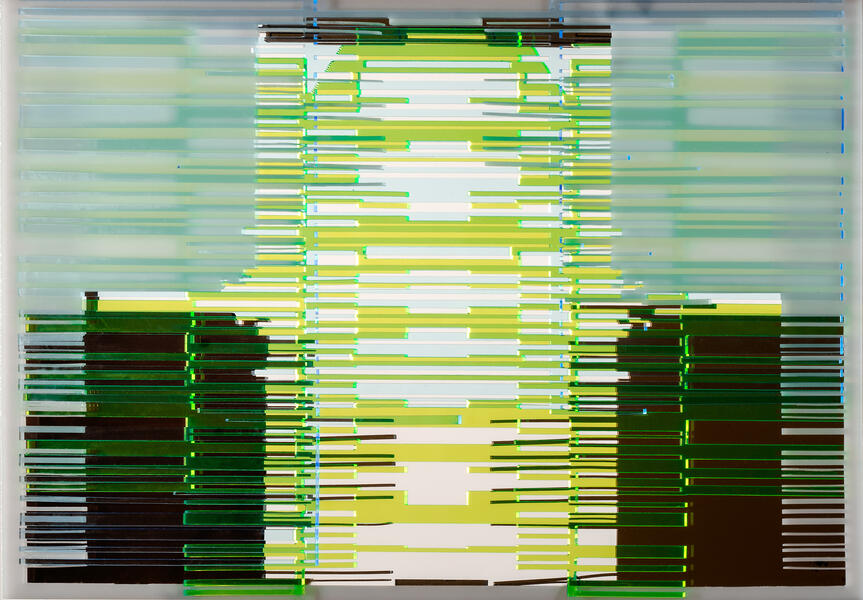 Barcodes: Merging Identity and Technology,2012
Barcodes: Merging Identity and Technology,2012Closeup of the interactive artwork by Soledad Salame in collaboration with Joyce J Scott, Pablo Cano, Soledad Salamé, Gabriela Morawetz, Fanny Sanin, Michel Varisco.
Curator and project coordinator, Amy Raehse
As people entered the installation in 2012, at Art Miami during Basel art fair they used the qr codes on the floor to get to different videos of the artists named above. I am exhibiting two of the videos that were done for this project.
Laser cut Plexiglass, Size 16"x 24"x1" each
-
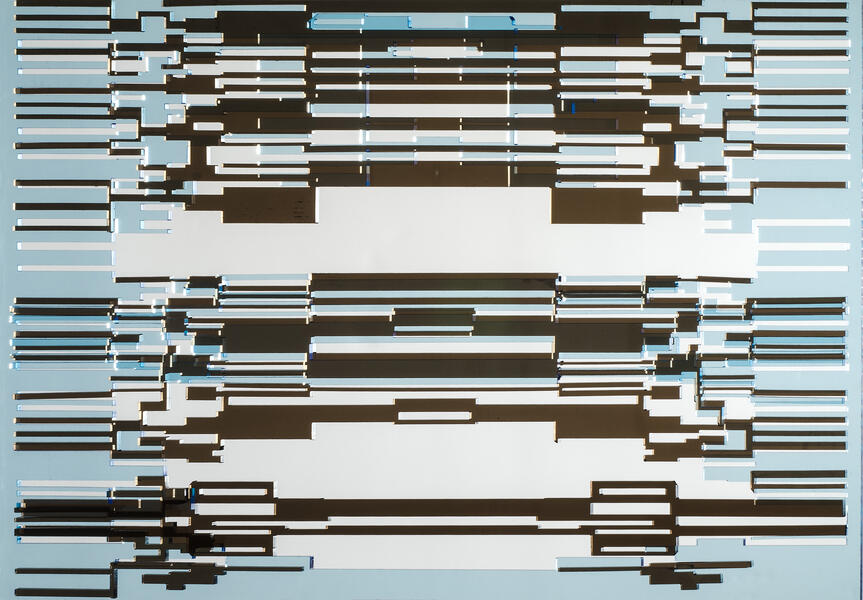 Barcodes: Merging Identity and Technology,2012
Barcodes: Merging Identity and Technology,2012Closeup of the interactive artwork by Soledad Salame in collaboration with Joyce J Scott, Pablo Cano, Soledad Salamé, Gabriela Morawetz, Fanny Sanin, Michel Varisco.
Curator and project coordinator, Amy Raehse
As people entered the installation in 2012, at Art Miami during Basel art fair they used the qr codes on the floor to get to different videos of the artists named above. I am exhibiting two of the videos that were done for this project.
Laser cut Plexiglass, Size 16"x 24"x1" each
-
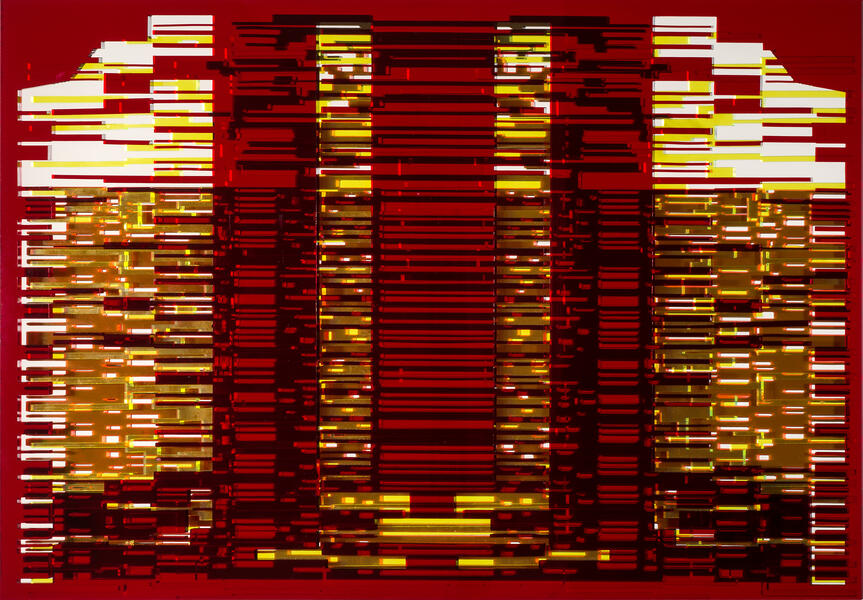 Barcodes: Merging Identity and Technology,2012
Barcodes: Merging Identity and Technology,2012Closeup of the interactive artwork by Soledad Salame in collaboration with Joyce J Scott, Pablo Cano, Soledad Salamé, Gabriela Morawetz, Fanny Sanin, Michel Varisco.
Curator and project coordinator, Amy Raehse
As people entered the installation in 2012, at Art Miami during Basel art fair they used the qr codes on the floor to get to different videos of the artists named above. I am exhibiting two of the videos that were done for this project.
Laser cut Plexiglass, Size 16"x 24"x1" each
GulfDistortions I-XII 2011
Soledad Salamé
2011 Project Statement
Gulf Distortions
Gulf Distortions I-XII
On April 20, 2010, a drilling rig explosion triggered the Deepwater Horizon oil spill in the Gulf of Mexico. The impact of the largest accidental marine oil spill in the history of the petroleum industry has continued long after the well was capped.
Enormously upsetting, the disaster and its global repercussions led me to develop the Gulf Distortions project. I drove to Louisiana after the oil spill, during the initial clean-up efforts. I traveled from Venice to Grand Isle with my collaborator Michael Koryta, talking to locals and taking photographs. The military and the police kept us from getting close to the contamination. The British Petroleum Company hired the shrimp fishermen to clean the spill with the agreement that they would remain silent about the gravity of the situation. Still, we managed to capture images of the marshes, floods, the remains of the local shrimping industry, and the oil drilling equipment that litters the coastline. The manmade aspects of the environment were starkly at odds with the raw beauty of the bayous. Based on these signs of struggle, it became evident to me that humans had been fighting against nature to lay claim to the landscape.
To visualize my sense of environmental fracture and displacement, I manipulated the photographs that documented our encounter with this disaster, submitting the images to an intensely fraught facsimile process. I worked with the staff at the St. Francis Community Center near my studio to simulate a cyber traffic jam, sending a number of photographic images by digital fax to the Center’s fax number all at the same time. The effect was to overwhelm the Center’s analogue fax machine, causing the output of highly pixilated images. For me, the combination of old and new technology holds metaphoric weight. The fax machine distorts the images in the same way that the human hand disturbs and distorts the nature.
The facsimile has become essential to the development of concept and process in my work. I became interested with the facsimile’s aesthetic properties in 2009, when Baltimore’s Contemporary Museum presented the Independent Curators International FAX exhibition. For the project, My Precious Islands, I created and faxed to the museum mock-ups of real and imagined floating landforms. I annotated the images with “loss of self, loss of control, loss of preciousness, loss of cities” to communicate a point of view at once nostalgic and critical.
For Gulf Distortions, I-XII (2010-2011), I chose 12 images that represent my sense of the estrangement between nature and humans. I transferred the images from digital to analogue, altering and abstracting their composition through the antiquated technology of the fax machine. I screen printed the reiterated images onto frosted Mylar and detailed the oil spill by printing on silver paper and by the use of interference pigments.
“A soundtrack commissioned by the artist enhances the foreboding mood. Composer Brian Sacawa’s discordant sound component blends saxophone, percussion, machine and wind sounds to echo the contrast between the tranquil, grassy landscape, the active shrimp boats and the visually raucous oil machinery.” –Laura Roulet in catalogue for Corridor (p. 40)
The damaged topography of the Gulf region is reflected in the resulting fragmented still life scenes. On another level, these formalist views of disaster speak to the rupture of our relationship with the world just outside our window. Our increasingly distanced rapport with nature—for example, our dependence on the internet for eco-status reports—has a had a numbing effect that could explain why we take such enormous risks in order to generate and consume energy. Our sense of place has been altered and with it, our notion of accountability has broken down. The lessons from the oil spill should lead to the development of new energy technologies with a minimum impact on nature.
-
 GulfDistortions I-XIITitle: “Gulf Distortions” Date: 2011 Media: Silkscreen on Mylar Size: Installation: 8’ X 7.5’ Individual panel (detail X 12): 22.5” X 32.5”
GulfDistortions I-XIITitle: “Gulf Distortions” Date: 2011 Media: Silkscreen on Mylar Size: Installation: 8’ X 7.5’ Individual panel (detail X 12): 22.5” X 32.5” -
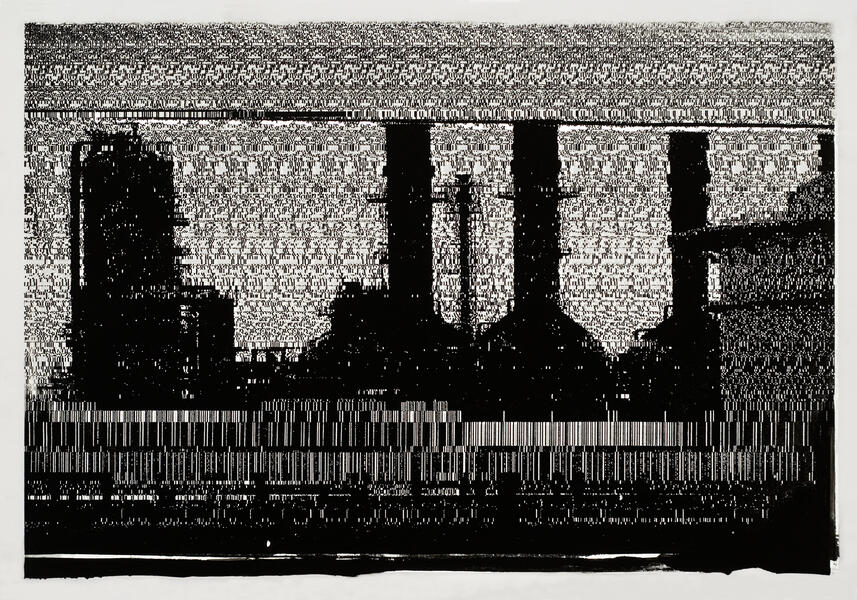 Gulf Distortions XIITitle: “Gulf Distortions” Date: 2011 Media: Silkscreen on Mylar Size: Installation: 8’ X 7.5’ Individual panel (detail X 12): 22.5” X 32.5”
Gulf Distortions XIITitle: “Gulf Distortions” Date: 2011 Media: Silkscreen on Mylar Size: Installation: 8’ X 7.5’ Individual panel (detail X 12): 22.5” X 32.5” -
 Gulf Distortions XITitle: “Gulf Distortions” Date: 2011 Media: Silkscreen on Mylar Size: Installation: 8’ X 7.5’ Individual panel (detail X 12): 22.5” X 32.5”
Gulf Distortions XITitle: “Gulf Distortions” Date: 2011 Media: Silkscreen on Mylar Size: Installation: 8’ X 7.5’ Individual panel (detail X 12): 22.5” X 32.5” -
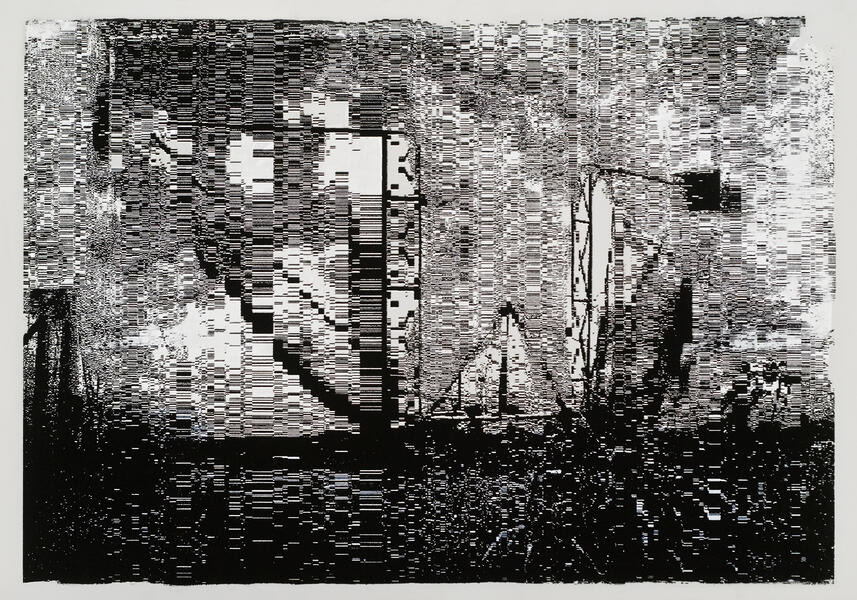 Gulf Distortions VIITitle: “Gulf Distortions” Date: 2011 Media: Silkscreen on Mylar Size: Installation: 8’ X 7.5’ Individual panel (detail X 12): 22.5” X 32.5”
Gulf Distortions VIITitle: “Gulf Distortions” Date: 2011 Media: Silkscreen on Mylar Size: Installation: 8’ X 7.5’ Individual panel (detail X 12): 22.5” X 32.5” -
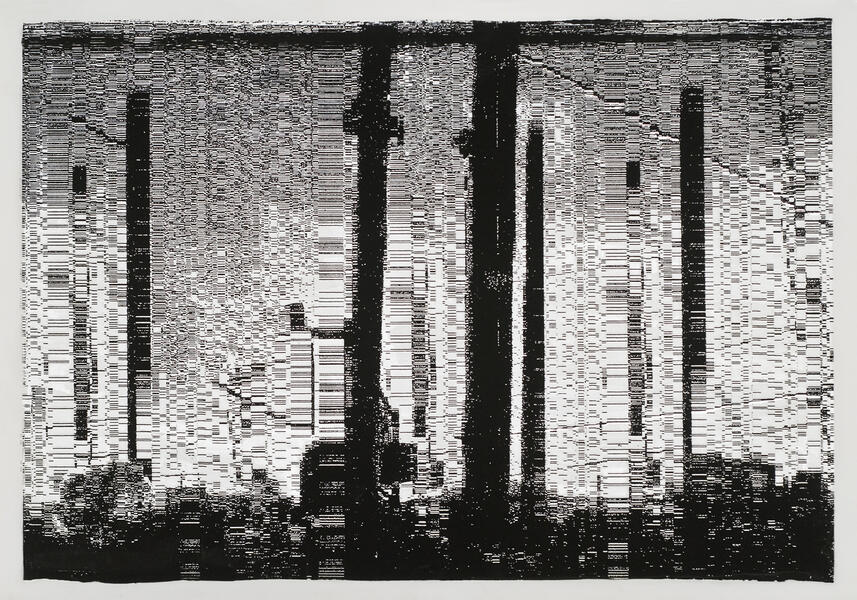 gulf-distortions-x.jpg
gulf-distortions-x.jpg -
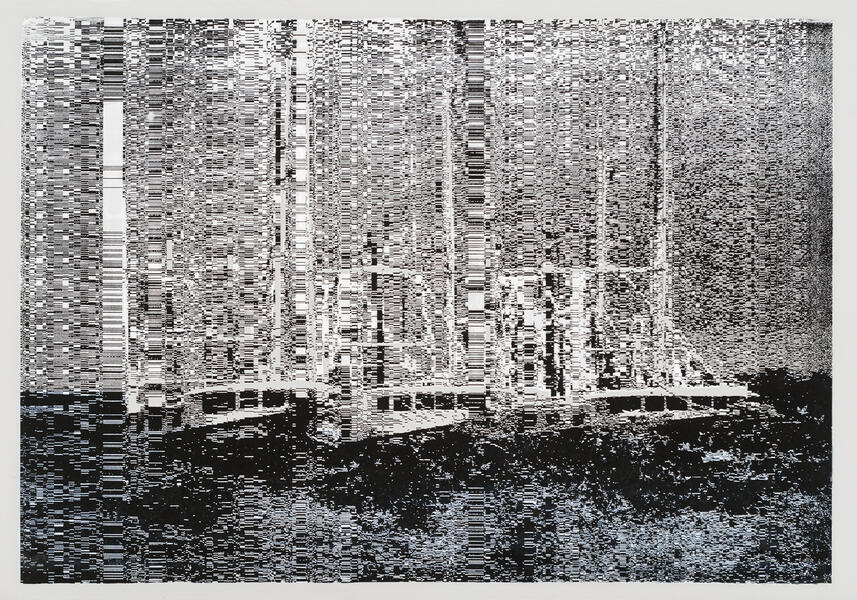 Gulf Distortions,IXTitle: “Gulf Distortions” Date: 2011 Media: Silkscreen on Mylar Size: Installation: 8’ X 7.5’ Individual panel (detail X 12): 22.5” X 32.5”
Gulf Distortions,IXTitle: “Gulf Distortions” Date: 2011 Media: Silkscreen on Mylar Size: Installation: 8’ X 7.5’ Individual panel (detail X 12): 22.5” X 32.5” -
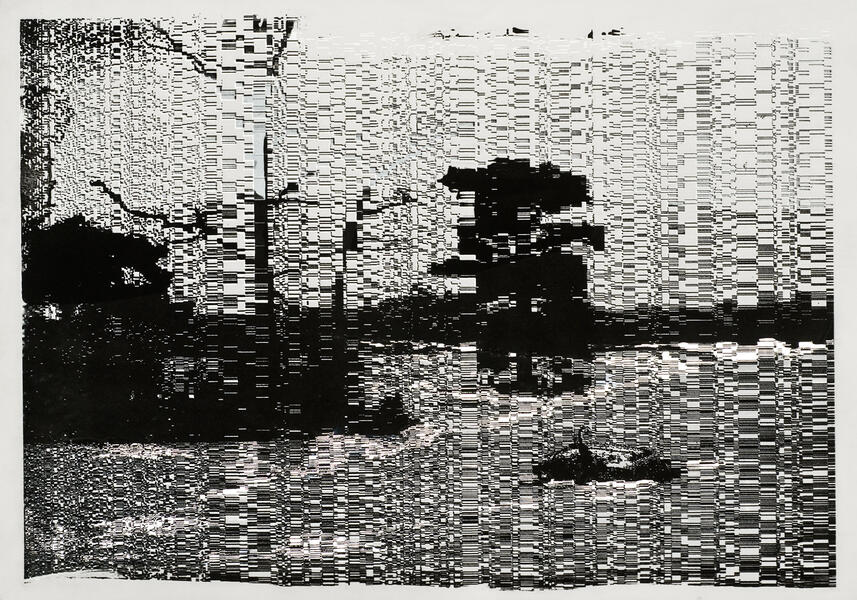 Gulf Distortions,VTitle: “Gulf Distortions” Date: 2011 Media: Silkscreen on Mylar Size: Installation: 8’ X 7.5’ Individual panel: 22.5” X 32.5”
Gulf Distortions,VTitle: “Gulf Distortions” Date: 2011 Media: Silkscreen on Mylar Size: Installation: 8’ X 7.5’ Individual panel: 22.5” X 32.5” -
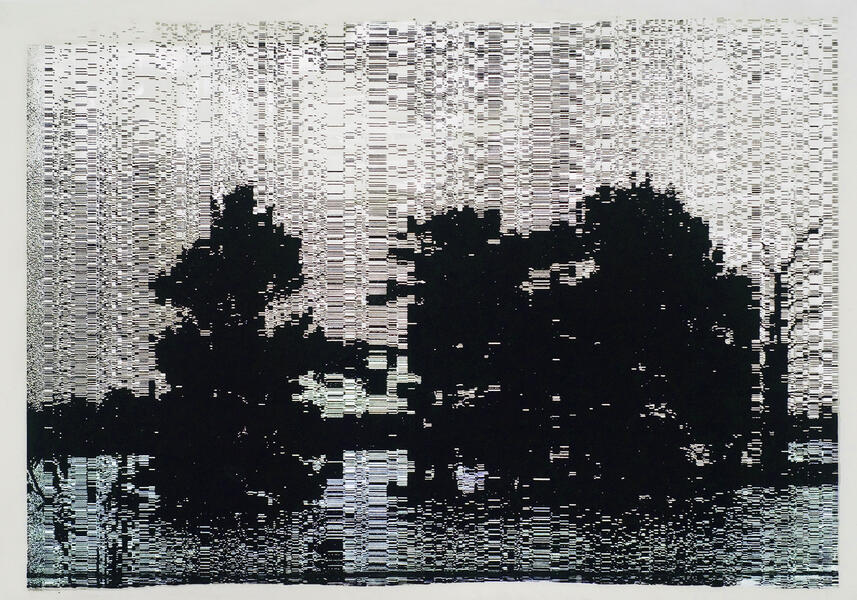 Gulf Distortions, IVTitle: “Gulf Distortions” Date: 2011 Media: Silkscreen on Mylar Size: Installation: 8’ X 7.5’ Individual panel 22.5” X 32.5”
Gulf Distortions, IVTitle: “Gulf Distortions” Date: 2011 Media: Silkscreen on Mylar Size: Installation: 8’ X 7.5’ Individual panel 22.5” X 32.5” -
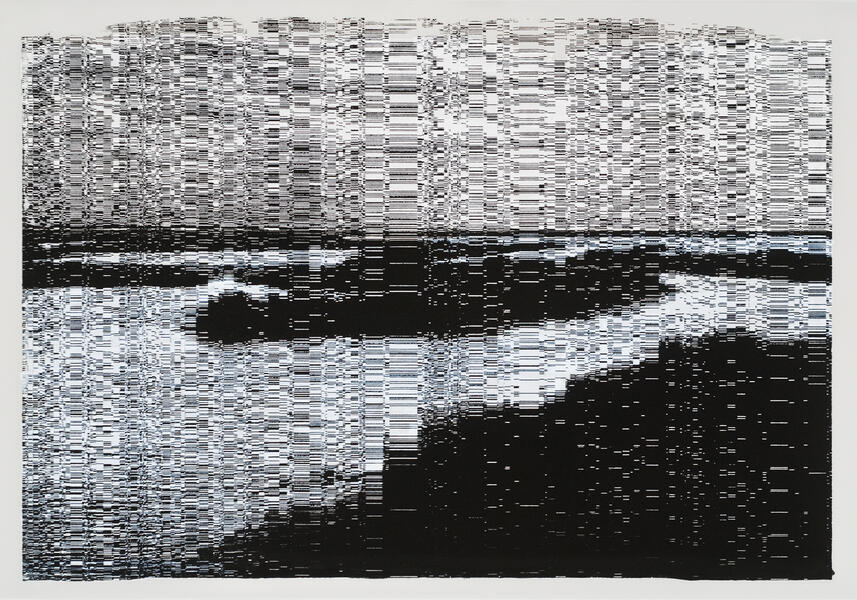 Gulf Distortions,II detailTitle: “Gulf Distortions” Date: 2011 Media: Silkscreen on Mylar Size:Individual panel 22.5” X 32.5”
Gulf Distortions,II detailTitle: “Gulf Distortions” Date: 2011 Media: Silkscreen on Mylar Size:Individual panel 22.5” X 32.5” -
Gulf Distortions Video
Installation with music composed by Brian Sacawa
Barcodes, Atmospheres & Islands 2009-2010
These are images of my latest work, which utilizes a combination of Monoprints, Solar Etching and Silkscreen printing to create heavily-layered, intricate prints.
The work is based on satellite imagery of cloud maps over the United States. I enjoy the idea that there is a constantly changing landscape of weather visible from above, while here below perhaps nothing changes. These works are a result of several years of research on satellite images of the earth, and as a development of my "Where Do You Live?" installation that I recently had at the Contemporary Museum.
"Soledad Salamé creates evocative works that reflect her passion for the earth’s natural resources. In her paintings, prints, photographs, and large-scale immersive installations, Salamé channels the energy and beauty of water, plant, and animal life to produce works that speak of global forces on both a micro and macro level. Organic forms often merge with digital referents, injecting Salamé’s seductive imagery with sobering concerns about alarming environmental science and the escalating presence of technology.
At the core of Salamé’s practice is a keen intellectual curiosity about the natural world and a love of research and discovery. Her interests have led her to the threatened forests of the Amazon, to the melting icebergs of Antarctica, and back home to the thousands of miles of eroding Maryland coastline. These visceral and awe-inspiring encounters with nature and first-hand experiences of the effects of climate change stir Salamé’s passion and inspire her forms.
In some of her most recent works, Salamé has focused her attention on the effects that global warming has on rivers, lakes, and oceans and what the future may look like if climate change is not addressed in our lifetime. Sinking islands in the Pacific, disappearing coastlines in the United States, and changing weather patterns around the globe, have all become Salamé’s ardent concerns and the source material for recent work. Satellite imagery from Google Earth and infrared images from weather research labs, for example, have become a significant part of her research and have found their way into her visual language producing works such as My Precious Islands (2009), Atmosphere in Blue (2010), and the recent large-scale installation Where do you Live?: Three Thousand Miles of Maryland Coastline (2009).
In Salame’s most recent work entitled Barcode (2010), technology moves from serving as her research and image-sourcing tool, to the subject of her work. In this series of silk-screened images on metal panels, the delicate shapes of small sinking islands are overtaken by a digitally produced and ever-expanding grid of a barcode. Distorting and abstracting with each panel, the barcode spreads out across each image, asserting the intensifying role of technology in our lives and its effects on the natural world. A ubiquitous machine-readable carrier of data, the barcode becomes the digital equivalent to the DNA code of every living organism. Executed in eerie hues of acid green, Salamé’s Barcode leaves us wondering which force—nature or technology--will prevail in the end and whether we even have a say in the matter."
--Irene Hofmann, Director, Contemporary Museum, Baltimore
-
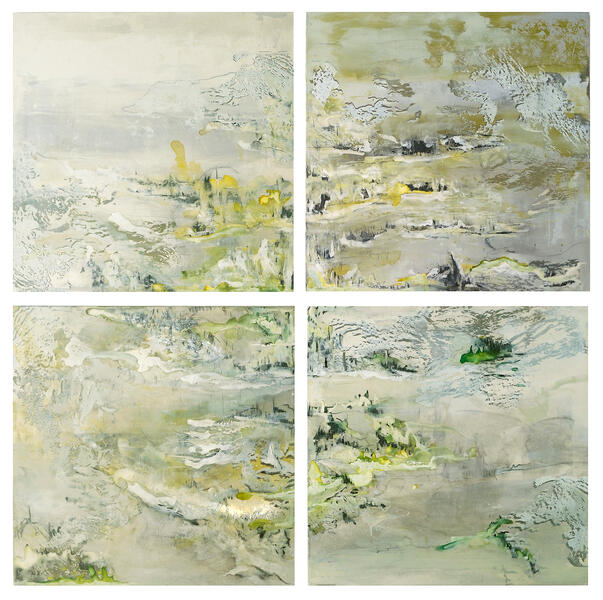 Ripples, I, II, III, IVRipples, silkscreen on Canvas, and mixed media, 36"x36" each x 4
Ripples, I, II, III, IVRipples, silkscreen on Canvas, and mixed media, 36"x36" each x 4 -
 Barcodes, I-IX 2010"Barcode" I-IX Silkscreen on Aluminum 21" X 30" (x9) 2010
Barcodes, I-IX 2010"Barcode" I-IX Silkscreen on Aluminum 21" X 30" (x9) 2010 -
 Cloud Map in Orange,2009AP edition of 10. Monoprint and Solar Etching, 22"x30".
Cloud Map in Orange,2009AP edition of 10. Monoprint and Solar Etching, 22"x30". -
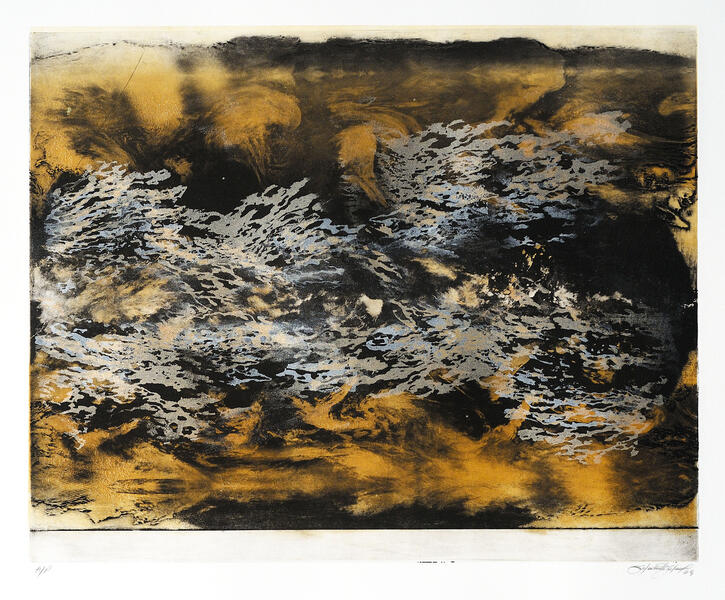 Breeze on Clouds II, 2009AP edition of 10. Monoprint, Silkscreen, and Solar Etching, 22"x30"
Breeze on Clouds II, 2009AP edition of 10. Monoprint, Silkscreen, and Solar Etching, 22"x30" -
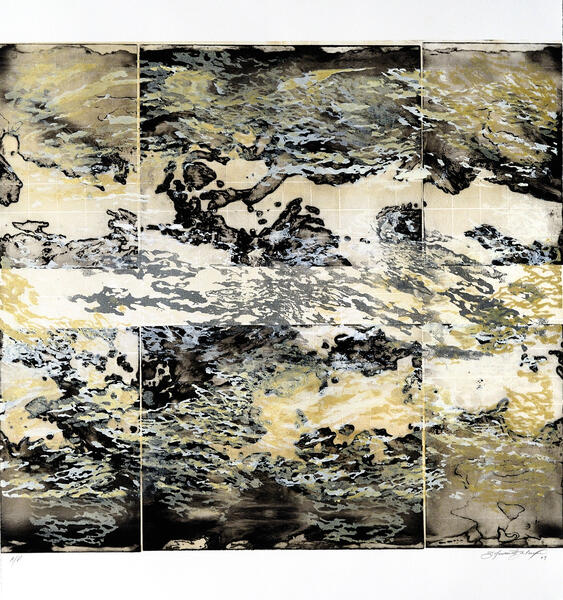 Atmospheres in Gold, 2009AP edition of 10. Monoprint, Silkscreen, Solar Etching, 20 1/2"x 22 1/2"
Atmospheres in Gold, 2009AP edition of 10. Monoprint, Silkscreen, Solar Etching, 20 1/2"x 22 1/2" -
 Atmospheres in Gold, 2009AP edition of 10. Monoprint, Silkscreen, Solar Etching, 20 1/2"x 22 1/2".
Atmospheres in Gold, 2009AP edition of 10. Monoprint, Silkscreen, Solar Etching, 20 1/2"x 22 1/2". -
 Atmospheres in Blue, 2009AP edition of 10. Monoprint, Silkscreen, Solar Etching, 25"x34"
Atmospheres in Blue, 2009AP edition of 10. Monoprint, Silkscreen, Solar Etching, 25"x34" -
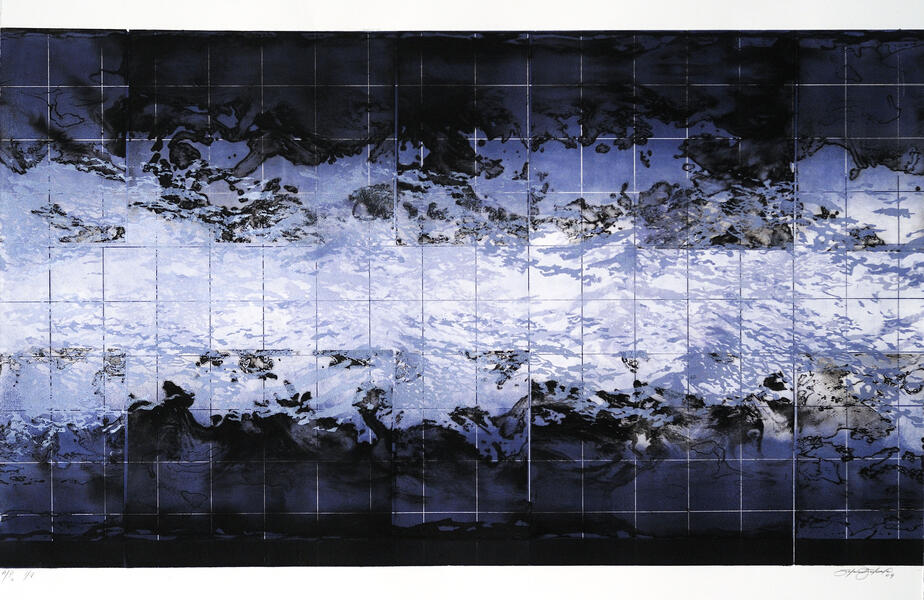 Atmospheres in Blue, 2009AP edition of 10. Monoprint, Silkscreen, Solar Etching, 25"x34"
Atmospheres in Blue, 2009AP edition of 10. Monoprint, Silkscreen, Solar Etching, 25"x34"
Where Do You Live? 3000 Miles of Maryland Coastline 2009
My work reflects my passion for the earth's natural resources and the people interaction with the landscapes. In my paintings, prints, photographs, and large-scale installations, I channel the energy and beauty of water, plant, and animal life to create images that speak of global forces on both a micro and macro level. In my recent works, I turned my attention to researching and exploring and effects that pollution and global warming have on our rivers, lakes, and oceans and what the future coastline may look like if global warming is not addressed in our lifetime.
Where Do You Live? is a dramatic 16-foot-long map of Maryland and its coastline. Created using a composite of hundreds of images from Google Earth, map, which is layered with elements of extensive research on the population, pollution, and increasing water levels along with the nearly 4,000 miles of Maryland's coast. The abstracted image of the landscape, coastline, and cities of Maryland offers a sobering view of the effects of pollution, a warming planet, and rising waters.
Contemporary Museum press release, 2009.
New Geographies 2008
I am fascinated by the idea of images in Science Fiction, of people living under water, but now, this fiction is becoming a reality. Using satellite imagery, I work with a miniature mockup in my studio, physically with water to show the possible futures of our coastlines. One of my projects focused on Venice, which is heavily endangered by rising sea levels. I have also worked with images of the Baltimore Harbor.
My next project, a mural titled "Where Do you live" ?
3000 Miles of Maryland Coastline", shows the possibility of flooding of coastal cities form Westernport to Ocean City. This project has two parts. For the first part I have selected five images to represent an area of coastline that is fifty three miles wide by 30 to 105 miles high. These five images are deconstructed and rearranged, creating an abstraction, and collaged to a silver background. The mural will be 8 1/2' tall by 18' long.
Using the collage as a mockup, the second part integrates water, so that cities and water become one. The collage is then photographed and printed on Mylar, with each section hand-colored and printed on metal. The end result is a mural that is eight feet tall and sixteen feet wide, with eight panels that are each four feet by four feet. This work may also function as a landmark, to see what changes may occur to the Maryland coastline over time.
The funds from the Baker award would be used to produce the project, part of which will be displayed at the Contemporary Museum next spring 2009 as part of series of exhibitions that explore the environment.
As an example of what I intend for "Where do you live?" 3000 Miles of Maryland Coastline, I am including The New Geographies project.
To see complete images for Venice I and II, visit my website under Printing>New Geographies:
http://www.soledadsalame.com
-
 Venice IIThis image is the result of a mockup of satellite photos of Venice, Italy; which was rearranged with water, photographed, printed on mylar and hand-colored. The resulting image is then printed on aluminum. 16" x 24"
Venice IIThis image is the result of a mockup of satellite photos of Venice, Italy; which was rearranged with water, photographed, printed on mylar and hand-colored. The resulting image is then printed on aluminum. 16" x 24" -
 Venice II A (detail)This image is the result of a mockup of satellite photos of Venice, Italy; which was rearranged with water, photographed, printed on mylar and hand-colored. The resulting image is then printed on aluminum. 16" x 24"
Venice II A (detail)This image is the result of a mockup of satellite photos of Venice, Italy; which was rearranged with water, photographed, printed on mylar and hand-colored. The resulting image is then printed on aluminum. 16" x 24" -
 Venice II C (detail)This image is the result of a mockup of satellite photos of Venice, Italy; which was rearranged with water, photographed, printed on mylar and hand-colored. The resulting image is then printed on aluminum. 16" x 24"
Venice II C (detail)This image is the result of a mockup of satellite photos of Venice, Italy; which was rearranged with water, photographed, printed on mylar and hand-colored. The resulting image is then printed on aluminum. 16" x 24" -
 Venice II B (detail)This image is the result of a mockup of satellite photos of Venice, Italy; which was rearranged with water, photographed, printed on mylar and hand-colored. The resulting image is then printed on aluminum. 16" x 24"
Venice II B (detail)This image is the result of a mockup of satellite photos of Venice, Italy; which was rearranged with water, photographed, printed on mylar and hand-colored. The resulting image is then printed on aluminum. 16" x 24" -
 Venice I A, B, CThis image is the result of a mockup of satellite photos of Venice, Italy; which was rearranged with water, photographed, printed on mylar and hand-colored. The resulting image is then printed on aluminum. 16" x 24"
Venice I A, B, CThis image is the result of a mockup of satellite photos of Venice, Italy; which was rearranged with water, photographed, printed on mylar and hand-colored. The resulting image is then printed on aluminum. 16" x 24" -
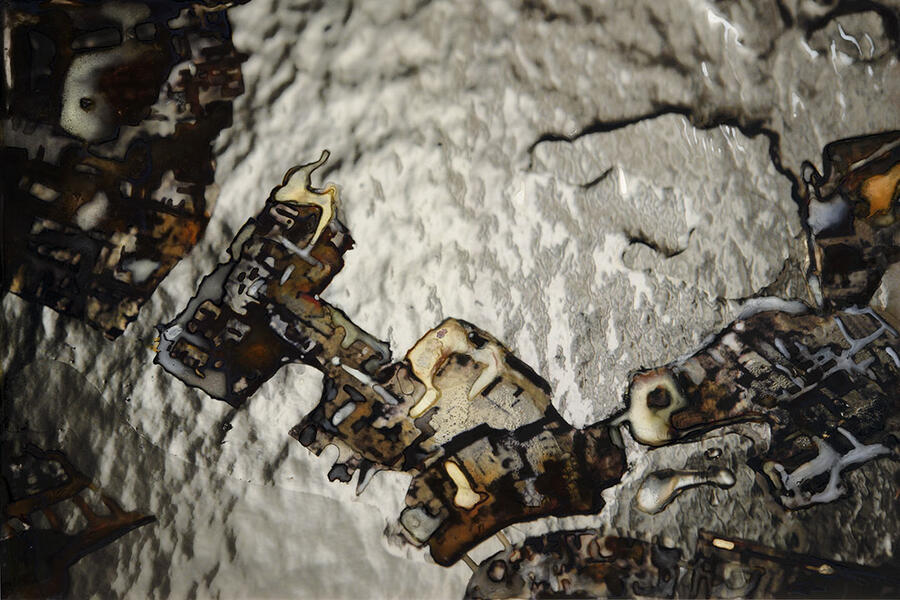 Venice I A (detail)This image is the result of a mockup of satellite photos of Venice, Italy; which was rearranged with water, photographed, printed on mylar and hand-colored. The resulting image is then printed on aluminum. 16" x 24"
Venice I A (detail)This image is the result of a mockup of satellite photos of Venice, Italy; which was rearranged with water, photographed, printed on mylar and hand-colored. The resulting image is then printed on aluminum. 16" x 24" -
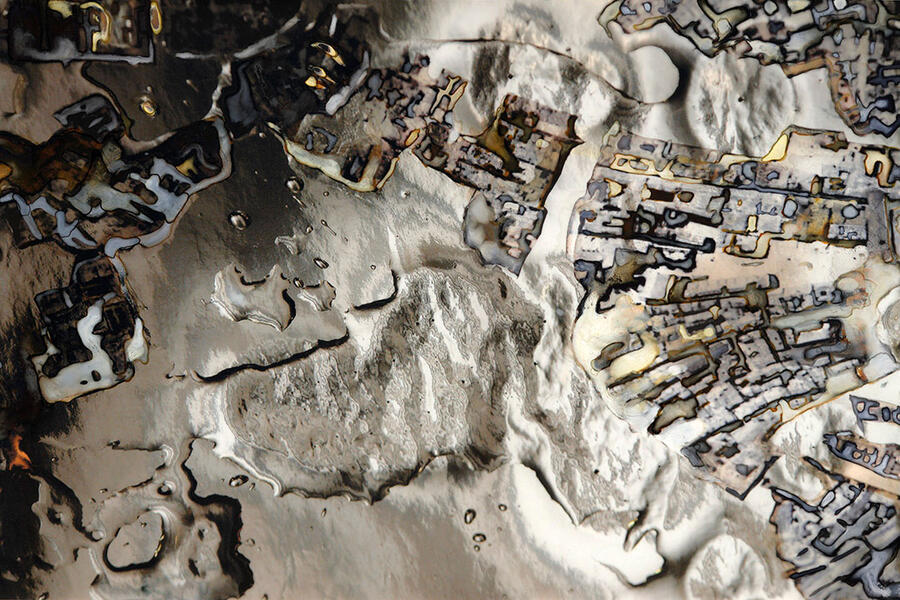 Venice I B (detail)This image is the result of a mockup of satellite photos of Venice, Italy; which was rearranged with water, photographed, printed on mylar and hand-colored. The resulting image is then printed on aluminum. 16" x 24"
Venice I B (detail)This image is the result of a mockup of satellite photos of Venice, Italy; which was rearranged with water, photographed, printed on mylar and hand-colored. The resulting image is then printed on aluminum. 16" x 24" -
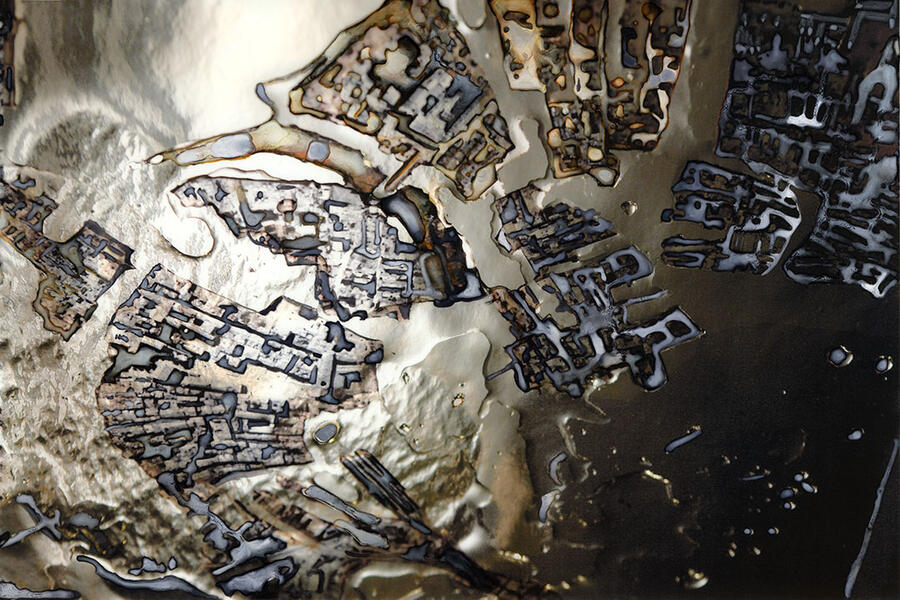 Venice I C (detail)This image is the result of a mockup of satellite photos of Venice, Italy; which was rearranged with water, photographed, printed on mylar and hand-colored. The resulting image is then printed on aluminum. 16" x 24"
Venice I C (detail)This image is the result of a mockup of satellite photos of Venice, Italy; which was rearranged with water, photographed, printed on mylar and hand-colored. The resulting image is then printed on aluminum. 16" x 24" -
 Baltimore Harbor IThis image is the result of a mockup of satellite photos of Baltimore Harbor; which was rearranged with water, photographed, printed on mylar and hand-colored. 13" x 50"
Baltimore Harbor IThis image is the result of a mockup of satellite photos of Baltimore Harbor; which was rearranged with water, photographed, printed on mylar and hand-colored. 13" x 50" -
 Baltimore Harbor IIThis image is the result of a mockup of satellite photos of Baltimore Harbor; which was rearranged with water, photographed, printed on mylar and hand-colored. 13" x 50"
Baltimore Harbor IIThis image is the result of a mockup of satellite photos of Baltimore Harbor; which was rearranged with water, photographed, printed on mylar and hand-colored. 13" x 50"
